
December 31, 2012
 CR Holiday Interview #13—Jason Grimmer
CR Holiday Interview #13—Jason Grimmer

 Jason Grimmer
Jason Grimmer is the manager of
Librairie Drawn And Quarterly, the bookstore run under the wider
Drawn And Quarterly umbrella. That a few publishers are running retail establishments is an intriguing story of the last several years in comics. There are all sorts of reasons why this might be a good idea for a publisher, not all of them vague buzzwords like "branding," and we get into a few of those below. I'm also generally happy to talk to members of the D+Q team because that's an important comics publisher with only a few, vital cogs.
Grimmer I don't know at all except as a presence in the comments threads of Facebook threads fostered by various other D+Q employees, alt-comics' go-to source for cheap, barely-penetrable, on-line entertainment. Google revealed very little other than he was once a prominent employee at Vancouver's
Zulu Records, a model indie music store. I got a bunch more information from fellow Drawn and Quarterly people, but I'm still unclear how much of what they told me is true. I tweaked the following a tiny bit for flow. -- Tom Spurgeon
*****
TOM SPURGEON: Jason, I know very little about your background. I'm told that you went to school for broadcasting, were one of the prominent employees at Zulu in Vancouver and that you even once called stock car races, but I'm not sure how much I'm being messed with. Can you talk about your background, how you ended up in retail? Was comics a part of your background?
JASON GRIMMER: Once I'd graduated from high school I figured I should go to school for something and so I chose radio broadcasting. I realized pretty soon it wasn't for me. I liked the news-gathering, copy-writing, and voice-over aspects of it but not the cultivating of a wacky on-air personality aspect -- which was encouraged. [Spurgeon laughs]
Though I barely remember finishing the two-year course -- indeed, I only discovered I'd actually graduated two years ago -- I did get to do my practicum at a radio station in
Calais, Maine and loved it. I was given free-reign to write copy, produce and voice commercials for local businesses, and it was a blast because I could create characters and use their library of sound-effect records anyway I wanted with absolutely no one over my head judging my work. When that ended and they couldn't hire me because of my Canadian citizenship, so did my broadcasting career. I knew it would never be better than that. After that, yes, I accepted a job as stock-car race announcer but I quit after one shift when I realized they weren't joking when they told me the pay was "all the hot dogs you can eat during your shift."
SPURGEON: Yeah, that's... [laughs]
GRIMMER: After a succession of short-lived bad jobs in various blue-collar towns: a bartender and DJ at a scummy biker/ dive bar (which I quit mid-shift one night after one particularly terrifying patron asked me "are you gonna play '
Witchy Woman' or do I have to take you out back and beat the shit out of you?"), at a car wash run by an ex-NHL player, and the overnight shift at a 24-hour video store, I picked up and moved across-country to Vancouver, B.C. where I eventually got a job as a manager at Zulu Records.
As far as comics go, yes, they were a very important part of my youth -- as important as movies and music were, anyway. I spent grades one through through as the sole
Anglophone in an
Acadian village and the
Peyo and Hergé I found in the tiny library at my school taught me how to read French. Also, my mother would bring me to used bookstores on a regular basis and I would stock up on whatever comics were there.

I remember liking
Conan the Barbarian,
Justice League,
Heroes for Hire.
Man-Thing, horror comics and
MAD magazines.
MAD was definitely a huge thing for me and I loved the weirdness of the humour and art -- which I found pretty subversive (Dave Berg creeped me out particularly). I kept thinking "I shouldn't be reading this," but was happy my mom let me. Loved Don Martin. I also read the comics in the
Playboy and
National Lampoon magazines my dad kept around.
Dirty Duck kind of blew my mind and it was also where I first noticed
[Harvey] Kurtzman (I was happy to discover of his stuff through
MAD reprints, later).
A couple years later I got into the
Spider-Man [Steve] Ditko-era reprints but, even though I found
The Inhumans fascinating as a concept, I found Kirby's art to be too impenetrable for me, at the time. Later I discovered the difference between
DC and
Marvel and chose to make mine the latter (except
Legion of Super Heroes, which I found fascinatingly bad). I kept up with Marvel until
John Byrne's
Alpha Flight and then lost interest in super-hero comics completely.

I was always pretty aware of first-generation underground artists -- knew their names and some of their work -- but I didn't pay much attention to owning anything. Mostly read some stuff that my friends' pot-head, older siblings had laying around. Much later, a friend lent me some issues of
Eightball and I started to pay more attention to comics again. A couple of years before I started at the bookstore, I started reading all the D&Q books I could find at my local library and the two that stuck with me -- and remain two of my favourites -- were
Seth's
It's A Good Life and
Gabrielle Bell's
Cecil and Jordan. Those, along with
Chester Brown's
Louis Riel (which I read much earlier) were my real entry points into D&Q.
SPURGEON: The Zulu experience seems like it would directly relate. Do you still use anything you learned in those days in the management of the bookstore? How do you look back on those experiences now?
GRIMMER: I worked at Zulu for around seven years. It was there that I discovered that, even though I believed my taste to be discerning, that I also loved researching and immersing myself in stuff that I thought I should at least find some appreciation for, in the hope that it would take. You know indie-records stores (and I would imagine this goes for comic book shops as well) are not always considered places that hire open-minded people, but that's how it really is and should be. The people who work there and the patrons that support them have invested themselves in knowing what's good about everything. These types of shops are, in many ways, the most important places in any city and can help shape the cultural life of the city or town they are in, if handled correctly. You can spend days searching for things on the internet but if there's a place in town that narrows it down just enough so you can get a foothold, it can change your life.
We stock things we love and can get behind but we also bring in things that our clients consider important. Generally, if it's in the store, there's a reason for it and we should be able to explain why it's there. We have a chance to alter the cultural landscape of our city and we should recognize and embrace that responsibility. We need money to stay open, sure, so we need to sell books, but in that regard we are also incredibly fortunate. Our clientele likes and buys the books we bring in so we don't have to worry too much about stocking huge amounts of million-selling books that we don't care about. This is the difference between
Amazon and a Zulu, between Amazon and a Librairie D&Q. When I was a kid with hardly any cash, I depended on the clerks at certain record and book stores to steer me in the right direction. Not necessarily tell me, "You have to have this or you're not cool," but if they could explain to me what something was about, where it fit in and why it was crucial for me to at least know about it, I was sold. If you can do that, you can consider what you do is important, in my opinion anyway. A knowledgeable, interested and approachable staff is integral to the success of this kind of business.
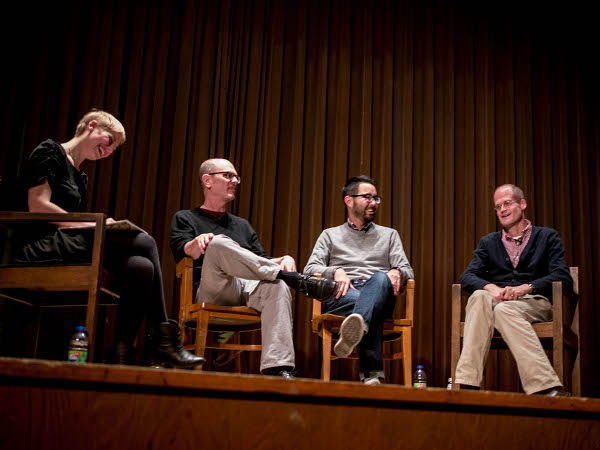 SPURGEON: I know the store celebrated its five-year this Fall, and I understand what they were thinking when they started it, but I'm not sure when you became involved. In fact, I'm not even certain how you went from Vancouver to Montreal. How did you end up with the gig?
SPURGEON: I know the store celebrated its five-year this Fall, and I understand what they were thinking when they started it, but I'm not sure when you became involved. In fact, I'm not even certain how you went from Vancouver to Montreal. How did you end up with the gig?
GRIMMER: My girlfriend, Kathy, and I played in a succession of bands in Vancouver and none of them were really satisfying experiences for us -- besides the obvious camaraderie and drinking. I knew that I liked being creative and liked -- to an extent -- the business of music, but we just didn't find the hard work it took for such small returns to be worth our while -- especially now that we were in our thirties. We figured that if we stayed there, we would be stuck in the same rut forever -- forming a band, gigging, recording, and then suffering through yet another band break-up.
Once our daughter was born, it gave us a reason to look eastward, partially because we kind of disliked Vancouver and partially because all our family was back-east and our parents would have better access to their grand-child. A lot of our friends were talking about buying apartments and flipping them and, since we had no interest in that, we decided to visit our family for vacation and not return. A month later we were living in Montreal. We had neither jobs, nor substantial savings, but I was fortunate enough to, right-away, find a part-time job at a record and used bookstore that barely supported us while Kathy went to school for Early Childhood Education. It was a tough couple of years, I knew some French and Kathy none.
Our daughter, Addie, became friends with
Tom and
Peggy's daughter, Gigi, at pre-kindergarten (
Chris and Marina's son, Charles, also attended) and our resulting friendship with her parents led them to offer me the management job at the bookstore when the position presented itself a year or so later. Tom, Peg, Chris and Marina are amazing people and have been very good to my family. Gigi and Addie still hang out almost every weekend, Tom and I drink together at our monthly comic book club meetings, Peggy and Kathy are in book club together, and we have a lot of shared friends, so we're pretty close. I'm the only person in this city that Tom seems to know who he can have really deep discussions about the
Velvet Underground or
Pavement with, so I have a huge responsibility in that regard.
SPURGEON: You're in a comic book club with Tom Devlin? I think I need to know as much about this as you're willing to tell me. Is there anyone else in this club? How does it work?
GRIMMER: Yeah, it's me, Tom,
Joe Ollmann,
Pascal Girard, D&Q managing editor Tracy "Hamcups" Hurren, store staffer, Marie-Jade Menni (who, incidentally, did her thesis on the Hernandez Bros.), and our good friend Howard Mitnick.
Matt Forsythe used to be in the club as well, but recently moved to Hollywood, I believe. We meet in the store after it closes. We all get a chance to choose a book for each meeting. We've done
Death Ray,
Acme Novelty #19,
My Friend Dahmer,
Dungeon Quests
1 &
2,
The Voyeurs and maybe a few more that escape me right now. We don't all always like all the books but there's always someone in the group who does and so we end up reading stuff we never would usually. We try to keep the conversation focused on comics but that can be tough sometimes as there tends to be a lot of beer involved.
 SPURGEON: You know, I'm not even sure I know the size and scope of the store. Can you break it down in terms of things like the size of the space, the size of any and all storage you might have, how many people work there, how many hours the store's open and what that means in terms of employee hours, how many events you run, that kind of thing?
SPURGEON: You know, I'm not even sure I know the size and scope of the store. Can you break it down in terms of things like the size of the space, the size of any and all storage you might have, how many people work there, how many hours the store's open and what that means in terms of employee hours, how many events you run, that kind of thing?
GRIMMER: The bookstore is somewhere around 800 square feet. There are two shelves near the back and by our stage where we store overstock and there's some space under the shelves for overstock as well. Honestly, everything we have is pretty much all on display, which is to say a lot. Right now, we have tons of boxes filled with
Building Stories all stacked neatly at the back waiting to be opened and shelved as the ones on the floor sell. The store is packed, but organized. It's a lot like my apartment in that way. As I mentioned there is a stage at the back and whenever we have an event we move all the tables to the side and put out chairs. This year we re-shelved the entire store so now we have wooden shelves that reach the ceiling and are better able to showcase some of our more beautiful and interesting books, whereas before they were all mostly spine out on black metal shelves. It's a beautiful space, really.
There are six staff members currently on the payroll. Myself and five others, but I'm the only full-time employee. The staff share most responsibilities but also has distinct duties as well -- French book buying, graphic novels etc. -- and I hire people based on their particular strengths. I'm fortunate because a lot of my hires come from a pool of the best former D&Q interns. If someone worked especially well in the office, Peggy will let me know and I interview them. The final decision is mine but if Peg and Tom and Chris have spent time with someone and suggest them, a lot of my work is done already. During regular season (that is, non-holiday season where we're open everyday from 10 AM until 9 PM) we open at 11 AM and close at 6 PM Sundays to Wednesdays and 11 until 9 the rest of the week. I'm there for two hours before we open so I can get ordering and other work done before we open. I don't have an office and am at the cash all day, so that time is necessary for me. I do a lot of researching books and booking events while having a coffee.
Events-wise, I'd say seven or eight events a month. More during the fall. One of my mandates when I took the job was to open the space up more for the Montreal literary community's use. We are constantly hosting launches by Concordia and McGill professors and students and I think this was the reason we were the only bookstore featured in
Time magazine's article on the Montreal Literary scene... Next fall I plan on starting the Librarie Drawn & Quarterly Reading Series where we'll host a few big-name authors off-site and then readings with other, lesser-known or emerging authors throughout two weeks in the store. I have a wish-list of big authors I'm always trying to get and I start really working on it in February so we'll see how it goes.
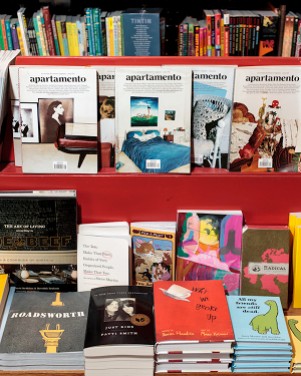 SPURGEON: How much of the store is D+Q-related material, how much is from other, similar publishers. How much is comics vs. prose?
SPURGEON: How much of the store is D+Q-related material, how much is from other, similar publishers. How much is comics vs. prose?
GRIMMER: One wall and shelf of the store is dedicated to D&Q, so -- and I'm really guessing here -- maybe 15%? People come from all over to see the "D&Q" store so we carry everything, of course. Besides that, the store is -- and please excuse the word, but it actually applies here -- curated, so we really only carry what we consider the best in almost all genres of literature. While we have lots of comics and graphic novels we also have a nicely maintained literature section. We have a small, but growing, poetry section, a theory section, art books, our favourite magazines, and probably the best English childrens' book section in town. We focus a lot on publishing houses that we consider to be D&Q kindred spirits:
McSweeney's,
Anansi,
La Pastèque,
Conundrum,
Nobrow,
Granta,
Toon Books,
New Directions,
Melville House,
Semiotext(e),
Koyama,
Fantagraphics, and more I'm forgetting right now. It all meshes pretty well with the D&Q aesthetic, so it works well.
SPURGEON: The anniversary article I read made a big deal about the exquisite way the store is curated. How much of the store's feel is you, do you think, maybe independently of a broader D+Q aesthetic?
GRIMMER: I inherited the shop so a lot of it was in place beforehand, and Tom and Peg and Chris' aesthetic is close to mine. I mean, I believe that was a big reason why the hired me and entrusted me with their store. What I've done is take what they started and kept moving in the right direction without having them feel like they always have to worry about it. They knew I had the right kind of buying experience and they knew what I liked, personally. We use
Book Manager as our POS and that's a massive help. They've been great and I do around 85% of my buying through that. I can track what sells and where and source out things from different suppliers pretty easily.
The office still plays a big part in the stocking of the store. They suggest stuff and the store staff does some buying as well… they all have great taste so if they consider something worthy, someone else is going to appreciate it as well. I don't question a lot of their choices, I learn from them. I could probably stock a whole store myself based on what I like and know about but you could also stock one based on what I don't know, so it's hugely advantageous to have this resource. There's also
Peter Birkmoe from The Beguiling whose brain I'll pick on a fairly regular basis. Besides buying, if any really big decisions are being made, we figure it out together and make things work. This is what makes the store as good as it is and the job so satisfying. I get to do what I like and enjoy a huge support system while I do it. I think it's working well.
SPURGEON: I will understand if you want avoid details, or maybe avoid the question entirely, but I hope you'll bear me out. Is the store profitable? You guys were quite up front in the anniversary article about grant money making it possible, and people in North America sometimes think everything in Canada is supported by the government forever.
GRIMMER: Oh yes, the great Canadian myth that everything here is funded by grants! Here's how I understand it: the office was able to secure a grant for the opening five years ago so they could fulfill the mission of providing comics, art and literary workshops and events to the public, which we still do. Tom does a graphic novel course and Pascal Girard does them in French. The amazing
Leyla Majeri does screenprinting workshops… I know this much: the store hasn't received any funding ever since, we are even unable to quality for library & institutional sales due to some bureaucratic red-tape. We are pretty much following the trajectory of any small business. I was told we were in the red for the first four years, and now, finally, we're in the black in our 5th year. Are we profitable? Well, it's an independent bookstore, so I think we all know the answer to that one. It's always a break-even affair. When you don't make any money the first four years, it's hard in the 5th when you come out a bit you hesitate to throw the word "profitable" around, as you can well imagine.
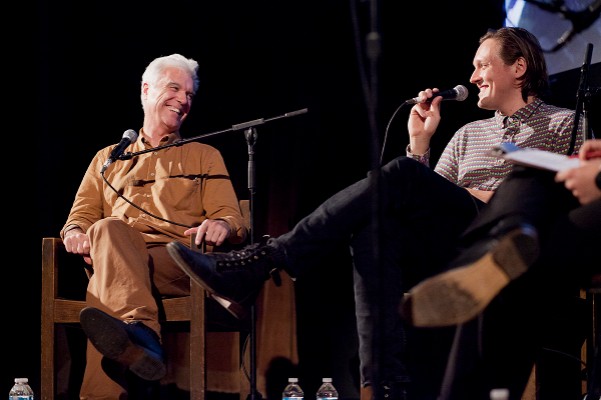 SPURGEON: I was wondering if you could talk about a couple of D+Q books, maybe a non-D+Q comics-related book, and a prose book with which you've done well. What are some of the distinguishing factors in terms of something that sells pretty well in the shop. How many would your best-seller for a year sell in a year?
SPURGEON: I was wondering if you could talk about a couple of D+Q books, maybe a non-D+Q comics-related book, and a prose book with which you've done well. What are some of the distinguishing factors in terms of something that sells pretty well in the shop. How many would your best-seller for a year sell in a year?
GRIMMER: Since I've been there I'd say the best-selling newer D&Q titles by a pretty wide margin were
Hark! A Vagrant,
The Death-Ray,
Paying For It and
Jerusalem. As far as non-D&Q goes, the
[Chris] Ware,
[Alison] Bechdel,
[Art] Spiegelman and Clowes back-catalogues in general are pretty huge and never stay on the shelves too long.
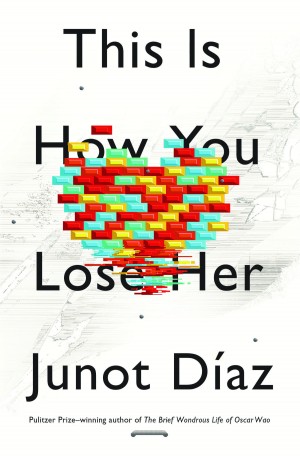
Otherwise, this year
Junot Diaz's This is How You Lose Her was big for us, which is a pretty cool for a hardcover fiction title as they can be hard to move in great quantities. It usually has to be a title that both the staff and our clientele embraces that makes a hard cover break out. Of course, we've had great success with local authors as well.
Rawi Hage,
Jonathan Goldstein… and this past year, mostly due to out very successful launch events with them, both
David Byrne's How Music Works and
Miranda July's It Chooses You were huge and we sold through hundreds of the books. What are great quantities in a year? I'd say a hundred or two, more in some cases. Quality of the title and the staff's love of the book definitely play a huge part in driving our sales.
SPURGEON: Does geography play a role in your store? I don't know where you are or anything about Montreal, but I know that bookstores can sometimes anchor a neighborhood. Are you a neighborhood store, too? Which neighborhood?
GRIMMER: We're located in the
Mile End, which has been a pretty hip area for the last decade. I guess the Arcade Fire hitting it big played a part in that. So did the cheap rent. The rent's gotten steeper now and as the younger students, artists, writers, and musicians all move north to the even-cheaper environs of
Parc Ex and
Petit Patrie, families are king. These families are mostly made up of
McGill and
Concordia professors and writers and artists and their children who are very invested in books and art (and mostly Anglophone) and so the store has become a kind of hub for them. The literature and children's section expansion is testament to that.
SPURGEON: Is there anything you wish you hadn't done, a step that maybe wasn't so fruitful, in the years you've been there? How do you feel you're still learning? Do you have room to try things and fail?
GRIMMER: Honestly, I've only been at the store for something like 18 months and I've been busy the entire time so I haven't had a lot of time to look back on anything I've done wrong. I don't think there's anything we've done yet that I would consider a failure. I put a lot of time into the store and I definitely have an amazing support system here so I have faith that any problem that may come up could be figured out. I'm a pretty careful person, generally, and everything I do with the store is worked out and thought through but I'm also aware that great things can't happen if you don't take chances. We would never let a great idea die on the vine.
SPURGEON: With the events, is there something that's key to making sure the events drive business to the store, as opposed to just being awesome events? I worked in a gallery once that threw amazing parties, but did so in a way that never led to people buying stuff off of the walls.
GRIMMER: Obviously, you can't sell 50 books at every event, but we always look at every event we book as potentially successful or we don't book it. There are a lot of considerations to take into account. A few months back, store staffer Julien Cecceldi did an amazing job when he decided he wanted to bring author
Chris Kraus to Montreal. Her books sell well enough for us and she's a store favourite, but we needed the resources to bring her here and book sales were not going to cover it so we partnered with Concordia University and did two events with her. One in the store and one at the school and they both did great. It was important to show people that we were willing to bring someone we thought was worthy. Sure it cost us a little but we knew it was culturally important. She had a great time and did two wonderful readings so that was, to me, as great a success as our 600-people sold out Byrne and Miranda July events. Yes, book sales at events are important, but future book sales are just as important and if you work hard and are trustworthy, people will support you.
SPURGEON: You mentioned people making a destination of the "D+Q store" -- do you get tourism attention? I know that was a factor in Subpop doing retail, that it's the kind of thing that gets listed as a city attraction and you get some business that way.
GRIMMER: Sure, especially in the summer. A lot of people think -- and hope -- that the publishing house is in the same building, but it's not. Soon after
Paying For It came out I had a young lady from California who told me she was a sex worker and that she just wanted someone at D&Q to know that she and her colleagues thought that Chester's book was tremendously important and that they really appreciated him for it. She knew we were a bookstore but she knew I'd pass it along. When authors are in town they generally always come by, and recently we had a customer get pretty excited when Peggy brought
Guy Delisle in. And Tom Devlin's usually by a couple times a week to drop off books or borrow my tape measure, so that can be a bit of a thrill. Kind of like if
Eddie Vedder stopped by the
Sub Pop shop to visit
Mark Arm and maybe borrow his guitar tuner while he was there.
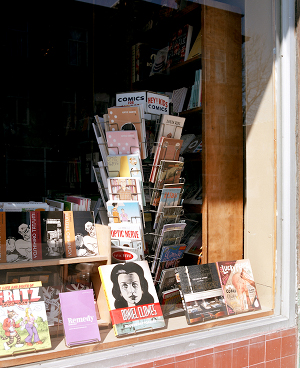 SPURGEON: Is there a customer you think you should have more of you don't yet?
SPURGEON: Is there a customer you think you should have more of you don't yet?
GRIMMER: I think we could probably reach out more to the other Anglophone communities in Montreal as well. We've started to do that a bit and I think its working. I see more people from
Westmount and
the West Island than I did last year. We need to beef up our French content as well. There's a lot of great stuff out there and it would be nice to be able to showcase it. We've had more requests for French childrens' book recently as well. I think that would be nice. I hate to turn people away when they are looking for beautiful books we could carry.
SPURGEON: How do you fold in children's material into a wider-range bookstore? Is there any key to attracting that kind of business, or at least being able to serve that kind of customer?
GRIMMER: The children's books fit perfectly. It's seamless, really. We do a lot of research with them and I'm confident that we are on top of getting in the best of the best. Aesthetics and content guide us and the quality of the illustrations is as important as with our comics and graphic novels. Matt Forsythe,
Lilli Carré,
John Stanley,
Isabelle Arsenault,
Frank Viva,
Alain Grée,
Julie Morstad, their work adorns our walls and we love it. Like I mentioned before, the Mile End is home to a lot of families and so our kids section is well-perused. My daughter comes to work with me once in awhile if my girlfriend and my schedules don't work out and she just sits in one of the little chairs in amongst all those gorgeous books with a pile of books and reads for hours. Lots of kids from the neighbourhood drop by and just sit and read. I pay attention to what they like or what their parents like and I stock accordingly. Childrens' books are great fun to research and stock.
SPURGEON: Are you settled in, do you think? Do you imagine what the shop might be like in five, ten years? How ambitious are you, and what might happen that we might read about that tells us you're on your way to making those goals?
GRIMMER: I'd say, yes, we're settled in. Our significance is felt, I believe and my job is to make sure that continues. We're more able to get authors to Montreal then we were when we first started because we're not Toronto and I think that will only get easier. I'm working on it anyway and I feel positive about it. As far as the future, yeah that's hard to predict. On one hand I think the need for thirst for great, beautiful books you can hold in your and shelve in your home will never abate but who knows how the E Book biz will affect graphically driven literature? I mean, maybe someone knows, but not me. I worked in record stores for so many years, I saw when MP3s changed everything but yet, there a so many great little record stores still around, and them seem to be doing OK. I mean, they have my business, anyway, for what it's worth. I still buy books and records on a weekly basis and my daughter is growing up in an apartment surrounded by them, but how many of her friends have the same thing? A significant number of them probably won't feel a need to cultivate that kind of environment in their homes when they get older. Maybe my daughter won't either. In cases like that then our store and stores like ours are even more crucial as we represent something that people know in their hearts is important but may not think about all the time. I can tell you this, I deal with people on a daily basis who tell me how relieved they are we exist. It's symbiotic: they exist so we do too. Buy a kid a book, will you?
*****
*
Jason Grimmer on Twitter
*
Jason Grimmer on Tumblr
*
Librairie D+Q
*****
* photo of Grimmer and the store by Alexi Hobbs; rights secured for
CR by Drawn and Quarterly
* Bobby London's Dirty Duck
* from
Cecil and Jordan
* photo of anniversary event by David Smith; rights secured for
CR by Drawn and Quarterly
* photo of store interior by Alexi Hobbs; rights secured for
CR by Drawn and Quarterly
* photo of books racked by Alexi Hobbs; rights secured for
CR by Drawn and Quarterly
* photo of David Byrne appearance by Richmond Lam; rights secured for
CR by Drawn and Quarterly
* a best-seller when it comes to prose at the store
* photo of window of store by Alexi Hobbs; rights secured for
CR by Drawn and Quarterly
* photo of Matt Forsythe's bookstore postcard by David Smith; rights secured for
CR by Drawn and Quarterly (below)
*****

*****
*****
posted 4:00 am PST |
Permalink
If I Were In Tokyo, I’d Go To This

 posted 3:30 am PST
posted 3:30 am PST |
Permalink
Go, Look: Tommy Couldn’t See The Joy

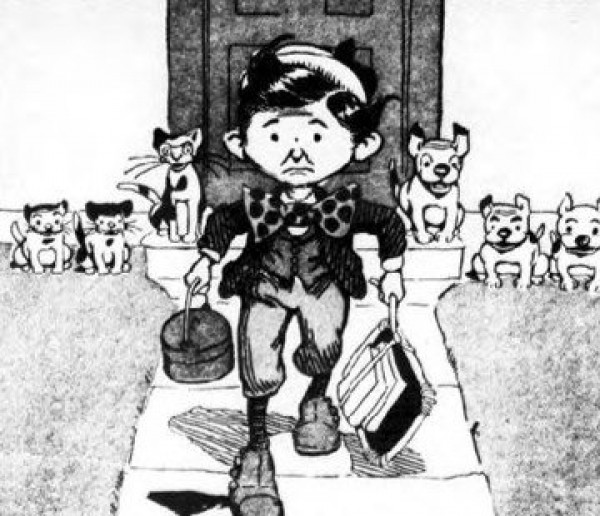 posted 2:00 am PST
posted 2:00 am PST |
Permalink
Random Comics News Story Round-Up

* the writer Peter David
apparently had a stroke while on vacation. I wish him a full and speedy recovery, and further hope that he and his family have as much comfort and support as is possible during this trying time.
Update: Kathleen David has a lengthy update and fuller description of events
here.
* Rob Liefeld begins his
year in review.
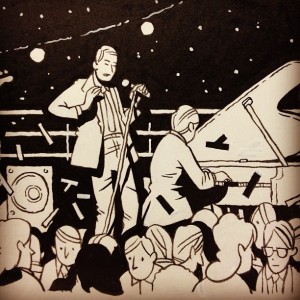
* linking to Jordan Crane's
tumblr initiative isn't a new thing, but I sure like the look of some of the individual panels he puts up that way.
* you can catch up with a bunch of Dan Berry interviews
here.
* Scott Marshall on
Last Days Of An Immortal. Cory Doctorow on
Rise Of The Graphic Novel.
*
cartoonist/musician Nate Powell matches comics to albums.
*
Michael Cavna communicated birthday wishes to Stan Lee from various other august personalities.
*
these Christmas Day strip postings at the Library Of American Comics blog were a lot of fun.
*
here's a look at an image from a forthcoming Craig Thompson kids effort.
Here it is bigger. That should be fun.
*
wow.
* Jen Vaughn
reports on an Esther Pearl Watson show in Texas.
* I'm never quite sure how to cover
news of these juggernaut webcomics-culture based kickstarter campaigns, because mostly I just sit there with the Little Rascals shocked face, staring at them.
* hey,
look at that CAKE ad. Lot of pressure on that show this year, lot of anticipation for it. Also found over there was
this Michael DeForge tribute to Leslie Stein.
* finally,
here are ten UK small-press comics you should own.
posted 1:00 am PST |
Permalink
December 30, 2012
 CR Holiday Interview #12—Tom Kaczynski
CR Holiday Interview #12—Tom Kaczynski

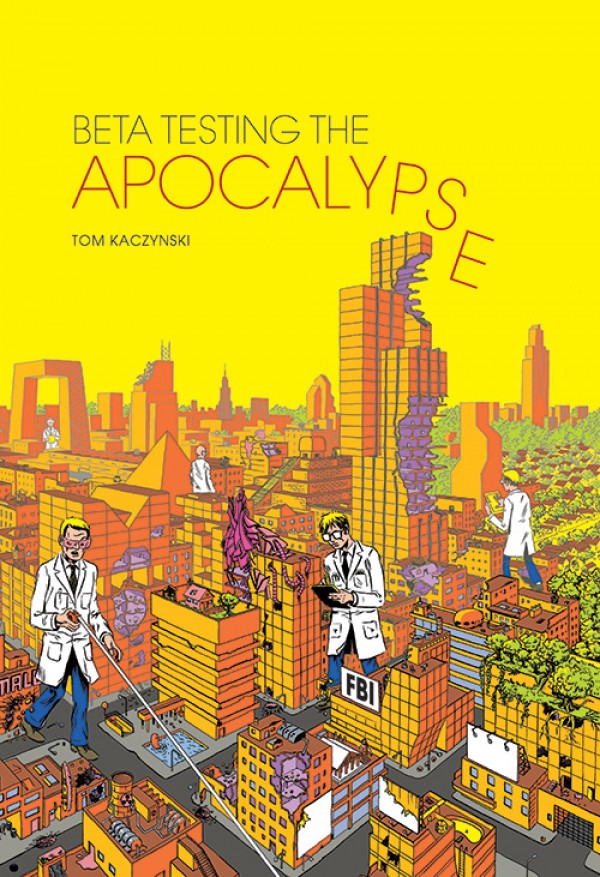
*****
 Tom Kaczynski
Tom Kaczynski had a very good 2012, escorting his line of Uncivilized Books to the trade and collections portion of the ongoing micro-publishing cotillion while seeing a fine book of his own out from
Fantagraphics.
Beta Testing The Apocalypse collects a number of Kaczynski's fine short stories from
the late MOME anthology and adds at least one major short story never published. His work reveals an inherent understanding of structures, of both the societal and formal/comics variety, which makes sense given his background in architecture. He is the only new publisher I've ever encountered in the alternative comics realm where people seem enthusiastically in his corner from the get-go, just sort of grateful he's arrived. Despite Kaczynski making comics for several years now, I have never been well-acquainted with him personally and as late as last year's
BCGF was openly mistaking his work for someone else's despite very much enjoying the individual comics as I came across them. I'm glad for this opportunity to have a better grasp on his significant presence in the world of comics, seeing as we should all benefit for years to come. -- Tom Spurgeon
*****
TOM SPURGEON: I want to apologize for the broad nature of some of these questions, but until I sat down and started looking at your work for this interview I'm not sure how familiar I am with your story. Let's talk about the publishing first. The initial impulse to publish: I know it's not unheard-of for a cartoonist that self-publishes and works with minis to go in that direction, but to make such a deliberate move the way you have with Uncivilized indicates there was some significant planning involved. Can you talk about the move into publishing?
TOM KACZYNSKI: Like you've said, I've self-published for a long time. Once I started working with
Gabrielle [Bell], working with her in mini-comics, we started getting a lot of good feedback in terms of what I was doing with her in designing her books, the quality of the little mini-comics being published. At some point, Gabrielle just sort of said, "Hey, do you want to do my next book?" [laughs] I wasn't a publisher at that point, really, I was just someone making mini-comics -- deliberately, but on a very small scale. So it took me a while to think about it. But once we sort of agreed I was going to do this, and I agreed to do it, I realized that for someone like Gabrielle, if that book was going to succeed, I needed to do something serious.
SPURGEON: How did the arrangement with Gabrielle come about with the mini-comics? I don't think I know that story, either.
KACZYNSKI: That was pretty simple. I'd known Gabrielle for a while. We were in the same drawing group in New York. We've known each other for years at this point. I started doing Uncivilized Books as a mini-comics imprint. She ended up coming to Minneapolis for a
Rain Taxi festival. We had talked about collaborating. Whether that was sort of a writer/artist collaboration, or something, we had talked about collaborating on
some level in the past. When she came for this
Rain Taxi festival in Minneapolis, I was like, "You ought to do something for the festival," because she was promoting -- I think it was
the Cecil and Jordan book. It would have been nice to make something for the festival.
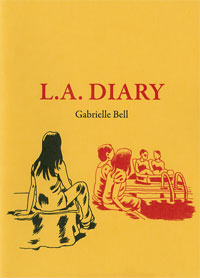
So we talked about it and put together
LA Diary. The mini-comic. The collaboration was that she just gave me the comics, essentially, and I came up with the way I thought it should look, and designed it and everything. We got a lot of really good feedback on that, so we just kind of kept doing that. Part of this was also just --
Drawn And Quarterly had at that point canceled most of their pamphlet comics, and she was looking for another outlet in that vein: something small she could put out more frequently. It just kind of worked out. We kept working together, and at some point it seemed like it was a good idea to do the book, too.
SPURGEON: So you have this realization that you're going to do this book and that it's different than this other thing you've been doing. So what do you do then? Do you do research? Do you sit down and make a plan?
KACZYNSKI: All of those things. [laughs] I've always been a fan of publishing. I've admired what Drawn And Quarterly has been doing, what Fantagraphics has been doing, what
AdHouse has been doing,
Koyama Press... all of those people. You're always going to think -- well, not everyone, but I do -- I think, "Oh, that would make a good book." Or "I wish that book had been done a little bit differently." I have these little, nagging thoughts now and then about certain things.
When the opportunity came up to do this book with Gabrielle, once the decision was made, I was like, "I need to become a publisher, I need to research this thing, I need to find out what I do for distribution, I need to find out how to do this thing." I didn't want to be a publisher that stacks up a lot of books in their house. I wanted to have distribution from the get-go... I just wanted to. One of the things I looked at were a lot of smaller, literary presses, who seem to have a lot less harder time finding distribution than a comics press. It seems like the comics market is really still bound up with, although maybe not so much anymore, the
Diamond Direct Market. If you can't get into that, it's hard to get anywhere else. A lot of the larger distributors weren't, at least for a long time, interested in comics to distribute. Drawn And Quarterly and Fantagraphics and
Top Shelf and other publishers have sort of opened that door. I think there's a lot more interest in the smaller press.
SPURGEON: So who carries you? IPG or someone like that?
KACZYNSKI: I'm with
Consortium: Perseus, I think, owns them. They also do Nobrow. When I showed this stuff to them, they were basically interested in comics publishers, I think. I was also lucky in that they're based in Minneapolis. Maybe I had an easier time having access to them. [laughs]
SPURGEON: I remember one thing that was surprising to me when Fantagraphics and D+Q started teaming up with established distributors is how good a match they were for those companies -- they're oriented towards producing a lot of books, they have an established design aesthetic, they can do a catalog. Has that been a good relationship for you so far?
KACZYNSKI: I think so. They're very much focused on indie, literary presses. Some of the people they distribute are
Coffee House Press, people like that. The comics I'm interested in publishing tend to be on the literary spectrum of the comics world, and so I think we definitely fit in. So far, so good. I've only been there for one season so far. I can't speak to a longer relationship at this point. [laughter] But I've been very happy with it so far and I hope it continues that way.
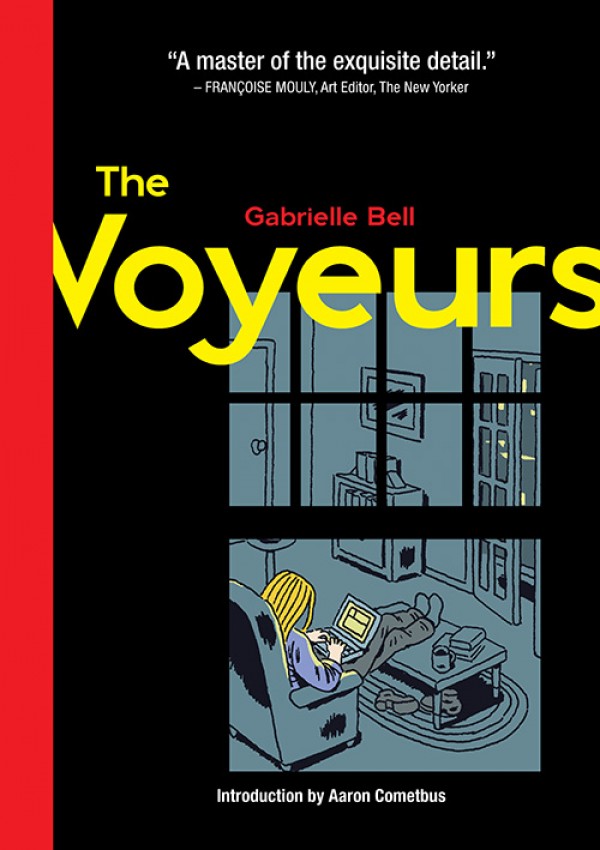 SPURGEON: How has that first season gone, then? What's your learning curve been like in terms of getting a book out there? Where do you feel you've learned the most in terms of Gabrielle's book that you can now apply to this new wave of publications you're doing?
SPURGEON: How has that first season gone, then? What's your learning curve been like in terms of getting a book out there? Where do you feel you've learned the most in terms of Gabrielle's book that you can now apply to this new wave of publications you're doing?
KACZYNSKI: Promotion is hard. Although Gabrielle did a lot of heavy lifting on this. She has a lot of experience promoting her books in the past, and she was able to bring that over to this book. It helped a lot in getting the book out there. Learning about the whole... pre-publication stuff.
Publishers Weekly,
Kirkus Reviews and others, where you have to send them stuff early to get reviewed or even considered. Just sort of seeing the cycle. Where you start and how far ahead you need to be.
Before it was always, "Hey, we've got this thing. Let's put it out there. We'll worry about what happens to it later." Now it's sort of there's this book, and it's going to come out at a certain time, this is what we're going to do for it, this is how many copies we'll print, this is where we're going to print them, and here's the budget. Just making sure all that stuff happens was a pretty big learning curve. At least initially. Now I'm sort of settled into it, but Gabrielle's book was the test case. We did have a lot of extra time on that book, because we were working on it for more than a year before it hit the stores.
SPURGEON: You toured with her on it.
KACZYNSKI: We did a west coast tour. It was supposed to include my book from Fantagraphics, but I was late with the book [laughter] so my book didn't really make it until the very, very end where we did an event at
the Fantagraphics store and we had a copy to show -- not even sell. It was pretty fun. Gabrielle did a lot of heavy lifting in terms of organizing the tour, because she's done it before. She had some relationships with some of the stores that we did. Having Consortium back the book up helped a lot. There was a lot less stress about getting books to these places.
SPURGEON: It sounds like it naturally developed, but Gabrielle strikes me as a good choice for a first book, because she's not only talented but she's settled into what she does. Can you talk a bit about Gabrielle as a cartoonist? I think she's still a hard sell for certain comics readers. I know it took me a while to come around to what she does.
KACZYNSKI: Well, why is that? [laughs]
SPURGEON: I don't know. I'm not sure why. I needed to be immersed in her comics before I picked up on a lot of what she did. Her facility and talent is obvious right away, but the entirety of what she expresses took me some time. What do you
think makes her a special cartoonist? Can I ask you that broad of a question?
KACZYNSKI: [laughs] Sure. First of all, she's getting better and better, I think. I think she's very much, she has a very literary voice. Part of why there's been some resistance to her work in the comics world is the autobiographical thing. For a while there was a major backlash. I feel like there was a lot of that kind of work coming out in the '90s, and then in the early 2000s there was like, "We have to do something else. No more of this kind of work." I think she approaches it from a very different place than the 1990s autobiographical work. It's a lot more literary, more of a memoir. Her books do a lot better for me in bookstores than in comic book stores. Her voice is a lot broader in a way that may not latch on with comics fans -- that's not to say she isn't popular there, because she is to a certain extent. Just maybe not as much as she is in the general book world.
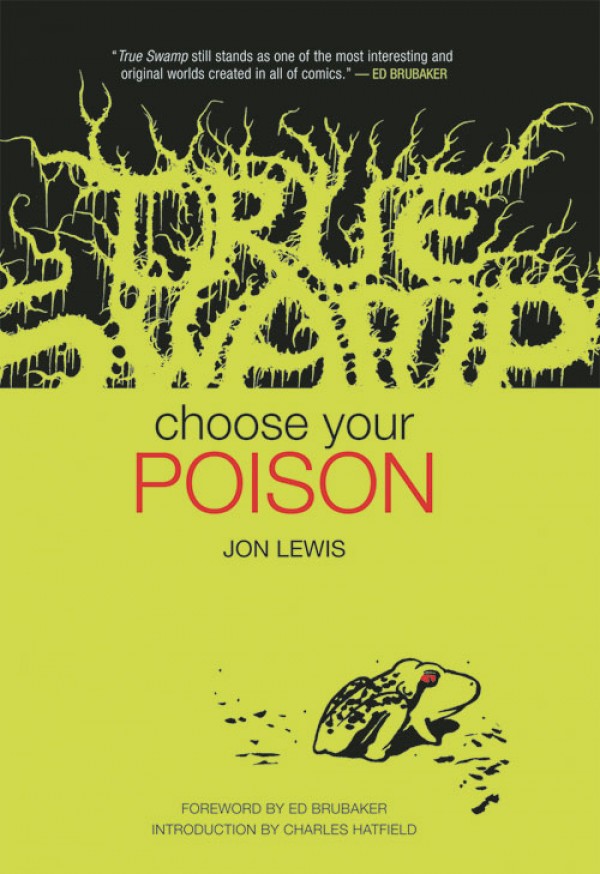 SPURGEON: The design work that you do... do you have a formal background in design?
SPURGEON: The design work that you do... do you have a formal background in design?
KACZYNSKI: It's kind of a formal background. I went to architecture school, which is sort of a design discipline, I guess. Not books, it's not graphic design, but it's a design discipline. I also spent a lot of time working... in college I worked for the college newspaper as a designer/art director. I never went into architecture professionally, but I went into design professionally after school. I've designed countless things. Web sites. Brochures. Anything you can think of. I hadn't done that much book design, because I wasn't in that world. It's something I always admired, and had friends that worked in that.
SPURGEON: Are there comics designers that you admire?
KACZYNSKI: Jonathan Bennett is an amazing designer. He's a great cartoonist and an amazing designer as well. I also like... he's not a cartoonist, but
Joel Speasmaker, he used to publish
The Drama. I admire his work. He has one eye on the comics world. He designed a bunch of stuff for the Brooklyn Festival this year, the Brooklyn Comics And Graphics Festival. I think
Jacob Covey at Fantagraphics really picked up the game for Fantagraphics' design.
SPURGEON: Enormously so.
KACZYNSKI: I feel like over the last decade or so the design of comics, graphic novels, has really taken a step forward.
SPURGEON: I'm pretty unsophisticated when it comes to design, but I like the overall look of your books. I like that you don't seem scared of type, working the titles into the overall visual effect. What do you think your strengths are as a designer?
KACZYNSKI: I don't know how exactly how to answer that. One thing that's frustrated me in the past about seeing certain books, like Gabrielle's work, is I've never really liked the way her books looked, to be honest. This isn't a big slam on anybody. We had a conversation where Gabrielle decided she wasn't a good typographer, essentially, so that was one of things we worked on together for her book. She's an amazing cartoonist, but there are a lot of amazing cartoonists that aren't good designers. There is this ethic in the comics world now that you have to do your own cover, do your own type. That's great if you're really good at that. But it doesn't serve everybody really well. That's something I wanted to address with what I was doing.
SPURGEON: Was bringing Aaron in to do the introduction your idea? I thought that was a great choice. Ed Brubaker wrote something for Jon [Lewis' book], and Charles was in there as well.
KACZYNSKI: Charles Hatfield. For Gabrielle's book, Aaron Cometbus, Gabrielle brought him -- it seemed like a no-brainer once I heard it. For Jon Lewis' book, Ed Brubaker -- I don't know if you read the actual foreword, he was basically the first reader for
True Swamp. It was kind of amazing to be able to loop that and have this book be introduced by him. Charles, I loved
his book on Jack Kirby, and he was a fan of
True Swamp. I feel like
True Swamp has been a bit of a lost book of the '90s. I wanted to have someone who was a fan of the book that could position it critically in terms of the recent history of the medium. He seemed like the perfect choice.
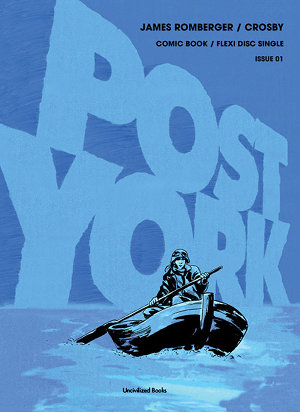 SPURGEON: Both Jon and James Romberger are kind of lost talents in a way. I don't mean that in a pejorative sense, but more that they haven't quite connected with a readership to match their talent.
SPURGEON: Both Jon and James Romberger are kind of lost talents in a way. I don't mean that in a pejorative sense, but more that they haven't quite connected with a readership to match their talent.
KACZYNSKI: I agree with you. I think James was a little bit... it seems like he was maybe in the wrong place. He's done some amazing work, but he's not very well known to the sort of audience that companies like Drawn And Quarterly or Fantagraphics or myself cultivate. He's been essentially a
DC/Vertigo kind of guy. He comes from that background a little bit. He has a pulp sensibility. But again, he's been recently converted to this, getting away from doing work for DC/Vertigo and trying out this stuff. I'm looking forward to
the Fantagraphics edition of 7 Miles A Second, which looks amazing. I just started talking to James last year at the Brooklyn Festival. He showed me this
Post York thing and it just kind of went from there. I loved
7 Miles A Second when it originally came out, and it's mystifying to me why some of these people aren't better known, or still published.
SPURGEON: Do you see a corrective impulse for your publishing, or is it fair to say that's something you like, that you can go find someone and present their work in a way that should be presented, to show their work to an audience you feel they deserve? Is that something that interests you?
KACZYNSKI: I guess that's part of the impulse. When I think back, I've always had a chip on my shoulder about comics generally. In high school I would write all sorts of essays for my English classes about comics, and trying to convince my teachers that comics are a legitimate literary medium. [laughs] There's always an impulse to redress a wrong, because they tended to dismiss this kind of work. I guess that's part of the impulse here. I'm definitely publishing other people that aren't forgotten or lost. [Spurgeon laughs] It's going to be a mix of things.
SPURGEON: Could you broadly outline your ambitions in terms of the structure of Uncivilized? Is there a certain number of books you want to do a year, a pattern you want to fall into?
KACZYNSKI: I don't want to over-extend, at least initially. There's no ambition to be a huge company. I would like to be a relatively successful small publisher -- maybe 8 to 10 books a year, maximum. Maybe some small things in between, pamphlet comics or minis. I still want to continue doing mini-comics. I feel like if I was going to sound corporate, that they're my R&D, research and development. You get to try out different techniques and different artists. It's a nice way to try out a specific aesthetic or a different artist without spending a lot of money.
SPURGEON: You mentioned talking to James at one of the Brooklyn shows; the 2012 version is where you and I talked to set up this interview. Certainly there's a lot of conventional wisdom out there that the shows and festivals have become increasingly important, that this year may be the best year of shows ever. From a publishing perspective -- or a cartoonist's perspective -- have the shows become more important, are they locking into a circuit?
KACZYNSKI: It feels that way to me. I feel like I have to be at a certain number of shows a year: to launch a book, to have something noticed or whatever. This is my first year as a publisher doing shows -- I think I did most of the shows this year.
SPURGEON: How many would that be?
KACZYNSKI: It's mostly from Fall onwards. From
CAKE, the Chicago show. Then
SPX, Brooklyn,
APE -- that's four shows for that half of the year. The first half of the year I didn't have any books. I was hunkered down, preparing for the rest of the year. I don't know. It's definitely been adding to the bottom line. The Brooklyn show was amazing. I had a really good SPX like a lot of people. Brooklyn basically matched the SPX numbers in one day for me. It was kind of amazing.
SPURGEON: What makes a good show for you, from a publishing perspective? Have you been able to figure out what the difference is now having done a few shows? Is it bottom-line sales, getting the word out, having a certain kind of book there, is there a formula for what works?
KACZYNSKI: It's still going to be a bit of trial and error with these shows. As I have more and more books, I'm going to have to figure out if I need two tables, how to bring people to shows, etc., etc. For the most part, the shows I enjoy the most, they make money at the very minimum. When the artists are around, and they're having a good time, and the show is vibrant in that I can walk around and see a lot of interesting stuff. I've been doing these shows for a very long time as a cartoonist, so all of those things you want in a show as an attendee works also for the publisher. If there's a lot of good work all around, everybody benefits. If there are a lot of new debuts, it brings in more people, and everyone benefits. Shows where it's a little bit thin on that, it's not so good.
 SPURGEON: Going into 2012 there was talk that business on the alternative and arts end of comics was slowing down a bit, that we were entering solidly into a down period after a slightly crazy period of book contracts with major publishers and festival hits and the established publishers in that world -- Fantagraphics, D+Q, Top Shelf -- finding their stride in terms of exactly what it is they want to do. And now we're in a down period where it's going to be a bit more of a struggle. There's a real optimism to this wave of micro-publishing we're seeing with Uncivilized and some others. It's like you're collectively voting to stick by comics. Eight to ten books a year for a literary imprint is an ambitious plan. I assume you're optimistic about the way things are going to be three, five, ten years from now, although maybe not -- maybe you're throwing stuff against the wall. Are you optimistic generally?
SPURGEON: Going into 2012 there was talk that business on the alternative and arts end of comics was slowing down a bit, that we were entering solidly into a down period after a slightly crazy period of book contracts with major publishers and festival hits and the established publishers in that world -- Fantagraphics, D+Q, Top Shelf -- finding their stride in terms of exactly what it is they want to do. And now we're in a down period where it's going to be a bit more of a struggle. There's a real optimism to this wave of micro-publishing we're seeing with Uncivilized and some others. It's like you're collectively voting to stick by comics. Eight to ten books a year for a literary imprint is an ambitious plan. I assume you're optimistic about the way things are going to be three, five, ten years from now, although maybe not -- maybe you're throwing stuff against the wall. Are you optimistic generally?
KACZYNSKI: Yeah, I think so. [laughs] It's a mixed bag. Always. But yeah, I'm optimistic. The boom you talked about, it was a different kind of boom. Maybe Fantagraphics and Drawn And Quarterly locked into what they were doing, but it was also a boom for the big guys to get in on graphic novels. It was a weird time, because that was kind of the first time graphic novels made it into the book market and they seemed to be performing very well and everybody was like, "I need to have one" without knowing what they were doing with it. I think what's happening now is that a lot of those books didn't do well for those publishers. They did good numbers, like if you sell 20,000 of something and you're
Random House, that's peanuts, right? That's a book that's probably not making money back for them. But for a publisher like me, that's an amazing number.
So I think that space is being abandoned by the big guys, a little bit. I think there's a mid-level list of material that's good that's being abandoned on the high end of thing. I think that's why there's this surge of smaller publishers that are realizing that there are these artists that are good and are selling but there's no interest from the big guys because they kind of got burned. I think there's a little bit of an opening for the micro-publishers here. And also there is so much more good work out there. There's a lot more new talent that's actively producing work and trying to make it work for them. I don't know. There's
something going on. [laughter]
SPURGEON: One of the ways you described what you were doing was in terms of it being sustainable; it seems like there is a built-in modesty to your plans that emphasizes something achievable as opposed to shooting a rocket at the moon and seeing what happens. It sounds like you feel that what you're doing may have a longer life than tossing $140,000 advances at random books, that that probably wasn't a sustainable model.
KACZYNSKI: There is a certain amount of modesty about that. At the same time, I make sure that every project I do at least makes its money back. So there are no losses. I'm not the kind of organization where I can lose money on things. I try to design everything and promote everything that there's enough to do the next project. Maybe do something more ambitious next time. I'm trying to create a sustainable model for this thing. It's still a work in progress.
 SPURGEON: I greatly enjoyed your new book. A lot of it was
SPURGEON: I greatly enjoyed your new book. A lot of it was MOME
stuff -- did everything appear in Beta-Testing
appear in MOME
?
KACZYNSKI: Pretty much all
MOME stuff except for the last story, which was brand new.
SPURGEON: I haven't talked to a lot of the cartoonists that worked for MOME
about that experience. I get the impression from people that for those cartoonists that published there, MOME
was really valuable in terms of keeping people productive and making comics and focused on producing work at a time when there wasn't a whole lot of structure out there.
KACZYNSKI: I agree with that.
MOME showed up kind of at a moment where both Drawn And Quarterly and Fantagraphics were abandoning the pamphlet model. This was the only place where a shorter piece could be published and seen by an audience, relatively quickly. There was no lag time for two or three years and working in complete obscurity for a long time. For me personally, it was amazingly valuable. I had a kick in the ass every four months to complete something. I didn't always succeed. The first four or five issues I tried to contribute something every time, and then it kind of slowed down for me a little bit.
 SPURGEON: How were you drawn into that orbit? Were you recruited? Did Eric [Reynolds] track you down and talk to you? Do you know how you came to their attention?
SPURGEON: How were you drawn into that orbit? Were you recruited? Did Eric [Reynolds] track you down and talk to you? Do you know how you came to their attention?
KACZYNSKI: I'd been going to comics shows for a long time. My comics had been out there. Eric had seen my
Trans minis and liked them enough to e-mail me and say, "Hey, I like this. Whatever you do next, show them to me." I showed him a few things I did after that and at some point, he said, "Let's put that in
MOME." It kind of went from there. It wasn't like, "Do something for me." It was more like, "I like your stuff, keep sending me stuff and we'll see what happens."
SPURGEON: You said once in an interview that you got to a point where you returned to comics after being away for a while and a big chance is that you spent more time on every page, on the comics themselves, than maybe you had before. Was MOME
good for you in that you had some leeway in terms of what you could send in?
KACZYNSKI: Absolutely. You always knew you couldn't do more than 10-15 pages max, because it's an anthology. It was nice to think about comics in smaller chunks. You could focus on telling stories with a beginning and an end in 10 pages, 12 pages, and focus as much as you could on that story. You could spend a little more time with it because it was only 10 pages, or only 12 pages. It was a very valuable thing to have.
It helped me get more serious about everything, too. I was serious, but when you don't have a venue like
MOME, for whatever reason you don't think about getting better -- or it's a slower process. When you're offered that venue, you're suddenly like "People are going to see this, I need to do something more serious." I feel like for me at least that was an important motivator. I'd been doing comics for 10 years before that -- publishing mini-comics for 10 years before that, I'd been doing comics since I was eight years old. It was always a little bit like, "Yeah, I'm just self-publishing this." Race to the end so you could have a new mini-comics, cut corners a bit. For whatever reason you're not doing yourself a lot of good --
MOME gave me an opportunity to
not do that.
SPURGEON: Was appearing beside certain peers also a motivating factor, that you didn't want to be shown up?
KACZYNSKI: That was part of it. I was also in this drawing group in New York, Jon Bennett was in it and Gabrielle, Jon Lewis was in it. A few other people. That was the first time I'd seen other artists do work. That was very motivating. How much work goes into a page, how much work they did, showed me that maybe I wasn't spending enough time on my pages. You know? It kind of went from there. The first few issues of
MOME I tried to do the best pages I can, I wanted to be the most interesting story in this issue. There was a little bit of competitive impulse.
 SPURGEON: A lot of the work in here is connected by the fact that they're societal critiques. You mentioned studying architecture, and the architects I know are very sensitive to the shapes of cities, city planning, infrastructure issues and the way things function and relate to one another. That's a lot of what your comics get at in terms of the quandaries they portray, this kind of fraying of societal structures. Is that an explicit interest of yours, this critique of society -- I know that you're well read, but I don't know how much of your reading is in that direction.
SPURGEON: A lot of the work in here is connected by the fact that they're societal critiques. You mentioned studying architecture, and the architects I know are very sensitive to the shapes of cities, city planning, infrastructure issues and the way things function and relate to one another. That's a lot of what your comics get at in terms of the quandaries they portray, this kind of fraying of societal structures. Is that an explicit interest of yours, this critique of society -- I know that you're well read, but I don't know how much of your reading is in that direction.
KACZYNSKI: It's a big interest. [laughs]
SPURGEON: Can you talk about how that developed? Did it come out of the interest in architecture?
KACZYNSKI: Architecture was something I got into mostly as a pragmatic major for somebody interested in art. I fell in love with the discipline, and as I got more into it I fell in love with all of the issues surrounding urban planning, infrastructure and how these things come about. Whenever you did a project of any kind, you had to do an archeology of a site. How did this site come about? Here's the original grid plan. Here's how it changed. Here's how this highway affected this area. Here's why this weird wedge of land exists. This and that. It kind of sucks you in, digging all of this stuff up about it. How there are very deliberate choices made at some point to create the situation on the ground. You just walk by it, you don't know it's something very deliberately created.
I've taken that to broader, philosophical kinds of things. The political systems that we have, the economic systems we have, someone at some point made decisions about policies that created the world we live. I want people to be aware they didn't happen willy-nilly, that a lot of these choices are deliberate and a lot of these choices can be changed. That gets reflected in the comics. With the
Trans books, they're more like philosophical tracts, whereas the
MOME stuff it's more fiction steeped in those ideas.
SPURGEON: There's an anxiety present in a lot of your stories. It seems like the kind of deliberate planning you talk about would be a comfort to a lot of people, that these things are planned. So I find the anxiousness curious. The fact that these thoughts are more arbitrary, or might reflect not-friendly impulses, is that maybe the source of the anxiety?
KACZYNSKI: I think the knowledge is comforting, but the anxiety... it's not even my anxiety but a general anxiety that in the US has been palpable since at least 9/11. There was an apocalyptic mindset. Things are falling apart. Things are coming to a head. There's a clash of civilizations going on. With the financial crisis, capitalism is cracking, and what does that all mean? I feel like I'm tapping into a little bit of that general anxiety.

Personally I'm interested in utopias as well. That's something I'm going to be more visible in my other book, the
Trans Terra book that's going to be coming out next year. There's all this anxiety, and it's very apocalyptic, and it feels like most people would prefer to see it all crumble as opposed to doing a few small things here and there to make things better. It's more of a frustration for me more than anxiety. It does come out in the comics as an anxiety. I think it's difficult to talk about. In the comics, especially the
MOME stuff, they're more literary in that I'm trying to get into the mindset of certain characters and people and how they would react to things where they don't know there's an underlying structure.
SPURGEON: Your comics are more focused on the mindset than the breakaway from the structured norm. There is a false apocalypse -- you're not as interested in seeing things fall down as exploring the mindset that believe that things are about to.
KACZYNSKI: Yeah, that's partly why the book is called
Beta-Testing The Apocalypse. [laughter] It's not the actual apocalypse. We're feeling it out. It's hard to say exactly. It's more like the anxiety of the apocalypse than the apocalypse itself. There's a whole post-apocalyptic genre, and that's something I used to be into, but I feel it's more interesting to find out how it came about. What happens before the apocalypse? Right before it. What needs to happen to society for that to happen. I don't know if you've read
Jared Diamond's work -- the scientist that wrote
Guns, Germs and Steel. He also wrote
a book about collapses of civilizations. That's another interest of mine -- ancient civilizations, and trying to imagine ourselves as a civilization that could end. How that could come about, and what mind set we'd need to get into to release and let go and let the whole thing crumble.
 SPURGEON: Your work seems very rigidly structured for the most part. You stick to grids pretty strongly, two-across and three-across, and your work is rigorously captioned. What is it about the standard grid that appeals to you?
SPURGEON: Your work seems very rigidly structured for the most part. You stick to grids pretty strongly, two-across and three-across, and your work is rigorously captioned. What is it about the standard grid that appeals to you?
KACZYNSKI: I've been kind of getting away from it -- especially in the last story. But yes, I do like the grid, I think it's one of the things, one of these sort of grammatical rules of comic that just works.
Kirby used the grid religiously, occasionally breaking out into big splash pages. The grid is the sentence. Each page has a certain amount of panels, and that's how you tell a chunk of that story, in those panels. It's this invisible thing. Sometimes you can question it, but for the most part it's just the next sentence. This modular thing that follows the other. I think it's important to break out of it every now and then. The kind of thing I do doesn't question the medium of comics so much; it's more about trying to create certain rhythms in a story, and I think the grid does that well. You can switch from three to two across, sometimes you just have a two-page spread or you break out of it altogether. Sometimes you have complicated grids like in the "Cozy Apocalypse" story. It's almost the default you go back to so that all the weird stuff you do stands out. You can't be that way all the time, otherwise it becomes incoherent. It creates a rhythm and it creates a structure. It creates a flow.
SPURGEON: Are you a confident creator? Are you still feeling your way through your stories, or are you empowered when you see a blank page?
KACZYNSKI: I'm still feeling it out a little bit. There's a lot of convoluted work that goes into these things. Occasionally, like the condo building story, that came together very smoothly. It was scripted, I drew it and and I inked it and it was done. "Wow, I'm getting this." Since then it's been a lot of back and forth. I rewrite whole chunks, and rearrange pages. It gets more difficult. Now that this book is done and I'm almost done with the
Trans book, my next project is to work with process more, and come up with a way of working that a little bit more comfortable. It's more like the grid -- a structure that moves me along more efficiently.
 SPURGEON: As you said, you do use formal effects, but you employ them very judiciously: a visual element that goes from panel to panel, or a sound effect that crosses a page. Are you
SPURGEON: As you said, you do use formal effects, but you employ them very judiciously: a visual element that goes from panel to panel, or a sound effect that crosses a page. Are you consciously
judicious in their employment?
KACZYNSKI: Yeah. I think the formal tricks are nice, but they almost work better when there are less of them. That's kind of my take on them. I tend to be deliberate with them. If something crosses a panel border, I want you to notice it and think about it. I've done more comics that explore the medium, that play more with formal tricks, in the past. It's more part of the repertoire now than something I'm deliberately going for.
SPURGEON: You've been making comics for a long time now. You've talked here and some other places about moments that were key in your development, like getting to be around other comics-makers and see how they approach a page. The idea of being more deliberate with individual pages -- eye-opening moments you've had along the way. Are you settled in now, or are you still sensitive to these experiences? Are you the cartoonist you're going to be for a while now? How important is it for you to consider new ways of doing things?
KACZYNSKI: I think I'm still pretty open. I just mentioned I'm looking for a new process. I really like
Dash Shaw's work. I've had a chance to peak at his process and it's really different from what I'm doing. We collaborated once on a story, and seeing how he works... it's very different than how Jon Bennett works. He's slower, he takes longer to put a page together, whereas Dash lunges forward and produces work more quickly, and he's able to come back in and rework certain things. There's an editing process that he has that I really admire. It's something that's difficult to do in comics. I'd like to work on that for myself, a process where I can able to produce work at a constant clip and also be able to edit.
When I was doing a lot of the
MOME work, what was great about it was being able to do these things, and they were so short I was able to wing it. If I had to redraw something, it was just one page. With more pages, you might not be able to do that. Having a process where you can edit is important, and I feel like that's something I've neglected. With longer pieces you need a process that will leave you alone, and feel like you're not falling backwards several steps.
*****
*
Tom Kaczynski
*
Uncivilized Books
*
Beta Testing The Apocalypse
*****
* cover to the new work from Fantagraphics
* photo by me at some show or another
* the
LA Diary mini-comic
* covers to the current works, showing off Kaczynski's praised art direction on those books
* a future book from Uncivilized
* a page from the current collection, showing society fraying if only needlessly
* a page from the more utopian-centered future work, provided by the artist, encompassing some of the themes discussed
* the
Trans Terra book, forthcoming
* a page with a rigid grid
* a panel that uses some formal trickery
* a snippet I liked (bottom)
*****

*****
*****
posted 4:00 am PST |
Permalink
If I Were In Tokyo, I’d Go To This

 posted 3:30 am PST
posted 3:30 am PST |
Permalink
If I Were In Seattle, I’d Go To This

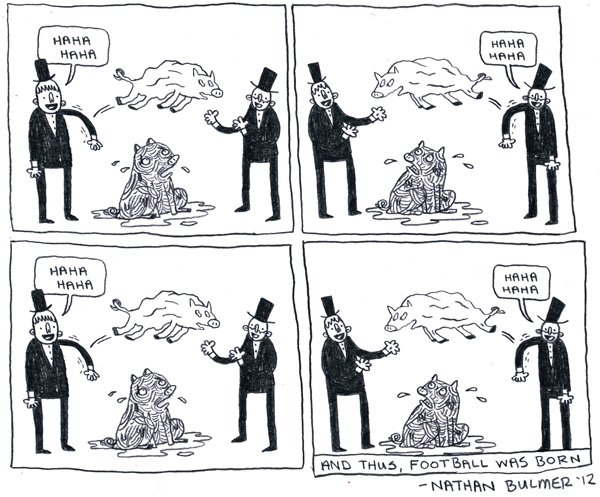 posted 3:30 am PST
posted 3:30 am PST |
Permalink
Go, Look: Saturday With The Seals

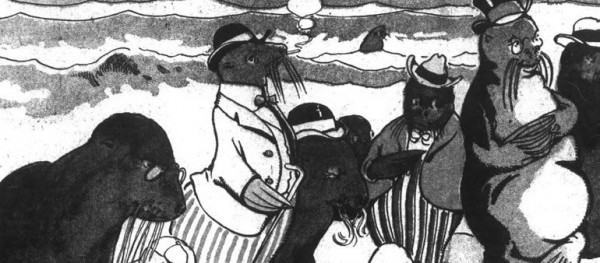 posted 2:00 am PST
posted 2:00 am PST |
Permalink
Random Comics News Story Round-Up

* somehow I totally missed that
a Staten Island comics shop closed in the wake of that Sandy storm from late October/early November. I know that a lot of businesses suffer this kind of thing, but I think it's a reminder that small businesses like comics shops are sort of uniquely fragile in terms of taking on too many blows like that storm caused.
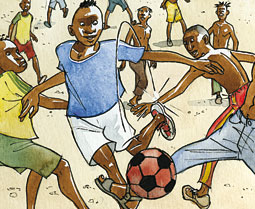
* Filip Kolek talks to
Baru.
* I always appreciate that some comics entities take some time off from the incessant hype and content production at this time of year, like
D+Q and
TCJ.com. I think that kind of downtime can be important. I know that I launched the holiday interview series against a much more grand backdrop of the comics industry and the culture that surrounds it taking a break from serious discussions of
Spider-Man story content or whatever. It's something I'll consider in future years.
* not comics:
another one for the "we're old now and will be dead soon" files.
* I also missed news of
new owners for JHU, and, from even longer ago,
closure of a second location for St. Mark's.
* not comics:
kiss your bookseller.
* not comics:
Jason has been running scans of pulp covers recently.
* not comics:
an atypical image for this artist.
* finally,
Natalie Nourigat went there and back again.
posted 1:00 am PST |
Permalink
December 29, 2012
 CR Holiday Interview #11—Rob Clough
CR Holiday Interview #11—Rob Clough


*****

<
posted 4:00 am PST |
Permalink
If I Were In Tokyo, I’d Go To This

 posted 3:30 am PST
posted 3:30 am PST |
Permalink
Go, Look: More Billy Bounce

 posted 2:00 am PST
posted 2:00 am PST |
Permalink
Random Comics News Story Round-Up

* David Brothers remembers
Barefoot Gen.

* so I guess
this is the last issue of
Moose, with extra pages and everything.
* Michael Dirda on
A Duckburg Holiday. John Kane on
a whole bunch of comics. Rob Clough on
Elfworld. Bob Temuka on
Footrot Flats. Johanna Draper Carlson on
A Wrinkle In Time. Sean Gaffney on
Blood Lad Vol. 1. J. Caleb Mozzocco on
Demon Knights Vol. 1. Paul O'Brien on
a bunch of different X-Men comics.
*
Johanna Draper Carlson picks her best of 2012.
*
it's been a long time since I've seen a post on Scott McCloud and terminology.
* Pamela Polston talks to
James Kochalka.
*
here's a list of books and comics read in 2012: always fun to see how comics folds into someone's wider reading life.
* finally, Darryl Cunningham
provides excerpts from a piece on Ayn Rand.
posted 1:00 am PST |
Permalink
December 28, 2012
 CR Holiday Interview #10—Mark Siegel
CR Holiday Interview #10—Mark Siegel

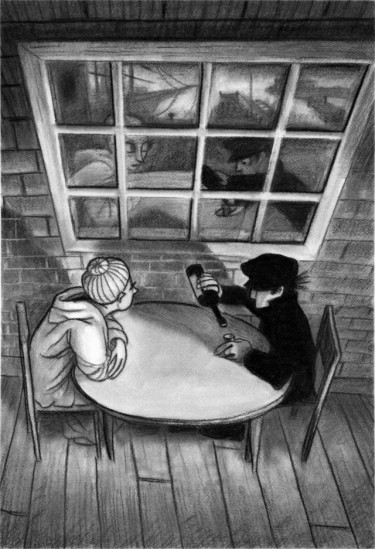 Mark Siegel
Mark Siegel is the editorial director of
First Second Books, the graphic novel imprint of
Roaring Brook Press. He is also an author and illustrator whose most ambitious work to date,
Sailor Twain, came out in October of this year following an ambitious, two-year, on-line serialization. First Second creators have included
Eddie Campbell,
Lewis Trondheim,
Gene Luen Yang and a significant number of authors oriented towards all-ages graphic novels, many of whom, as we discuss below, confuse me. I always enjoy talking to Siegel at the various funnybook shows we both attend, and this year at
San Diego's Comic-Con International he seemed almost blissful about the direction of his company. I also always wanted to talk to someone who works both side of the creator/editor divide in the same calendar year. Mark indulged my curiosity about all of this and more mid-December. -- Tom Spurgeon
*****
TOM SPURGEON: I have a question for you, a potential first question, that I wanted to put up front because if it sucks I could easily fast-forward past it. [Siegel laughs] You just came off of an author's tour, an extensive one, and I have to imagine that can be a pretty strenuous thing. You also have a ton of professional responsibilities at First Second. One of the things I'm fascinated by in comics right now is how people our age -- we're near the same age -- stay in shape. Comics people aren't always known for taking care of themselves.
MARK SIEGEL: Yeah.
SPURGEON: It seems there's a mini-trend of people reinvesting in that kind of healthy living. And I wondered if that's ever been important to you, the physical fitness thing, or at least finding a way to do everything you do and maintain a healthy lifestyle.
SIEGEL: I had my own health scare about 10-12 years ago. It forced me to really devote some time to setting up a lifestyle as opposed to just wining it on whatever. As you know, that's a tough time in your life, but it's also a blessing. You basically pay some bills on how you've been living. I do try to have some sense of that. A big part of it for me, a big part of the balance of health, is having certain patterns and routines. Including creatively. I think your creative health is kind of inseparable from your physical health. For that, being able to set routines, my early morning studio stuff, and my work time, and then of course when you hit the road and do the author thing that's definitely a source of imbalance and I'm feeling, I'm definitely feeling some burnout from having scrambled some finely-tuned patterns in my life. [laughs] I'm hoping to find my way back to a certain kind of balance.
SPURGEON: Just getting the amount of work done that you get done seems to me it would take a considerable amount of thought. It's not unprecedented in comics, your kind of split responsibilities. A lot of publishing figures have also been creators. A lot of folks have found their own way into that kind of balance. Was it more difficult for you when you first started?
SIEGEL: Not really, because in a way it predated First Second. First Second came along, before that I had jobs in publishing that really were more like day jobs. First Second came along, and it's more... there's a part of it that's really dayjob in terms of the admin work, the managing side of it all. But First Second is also a baby in a creative sense? It's a project. It's a project, so it has a different kind of nourishment than just clocking in for a paycheck.
Before First Second started, I knew... when I was just a designer at
Simon & Schuster before that, I knew that I had to safeguard my project time, and fight for it fiercely. There are so many people that put off that novel they dream of writing, and it eventually becomes the regret of their life. I knew I never wanted that. It's true I think that you pay the price of what you want to do. If I wake up... I found for me that carving up some time that wasn't yet claimed by everyone and everything else had to be really early morning. Most of my life I've been a night owl, but I've reprogrammed myself. So early mornings became that time. As I expanded that time, I had to push further earlier and earlier into the morning. The price of that is I'm not going to have much of a social life, because I'm useless after 10. That's a price I was happy to pay.
SPURGEON: Do you find that that has an effect on the way you create, though? I know that when I talk to artists with a demanding day job, maybe even a few of whom are in that early phase of having a family, they find they make stronger and quicker choices out of necessity.
SIEGEL: Yeah, I think it's true. I think it's true. I know it's a total cliche, but they say if you want something done you give it to a busy person. I think there's something about... when I think back on my twenties, and when I look back, I think in a way I had so much time on my hands and I have so little to show for that time. Those years. And of course, there are different things that you're going to be drawn towards in your teens or your twenties or your thirties or your forties... it changes, definitely. But I feel that as I've grown older and busier, that the time being more precious tends to be invested rather than spent. You can't really have a life without downtime, without empty, vacant time. That's also important.
It's basically become a set-up for me of a life that's like many little lives, where I know that 15 minutes can count, half an hour can count, especially if I know it's every day. At the end of a month, there's a lot to show for that. As opposed to always waiting to have that good marathon session in the studio. I know this from working with comics people, some very talented comics people, that some people have more of a struggle with their productivity than others. And oftentimes I hear they're kind of like, "This weekend, I'm going to give it a good, six-hour run and that should be great." And of course those six hours never come. As opposed to those people that never let themselves grow cold and they stay warm on a daily basis and it's maybe less spectacular and in the end it kind of wins the day.
SPURGEON: Let me turn that around. Something that's come through with talking to people on the road this year, people that have a teaching or a publishing gig, a lot of people approach those jobs as their being artistic projects as well. You talked a little bit about First Second being a creative project. Do you think First Second is different for having an artist in your position with the imprint, that you can develop it in terms of its own creative life?
SIEGEL: I hope so. And I know I'm not alone. There are some really talented authors and artists running...
Chris Oliveros has his own comics. It's a funny thing. There's this impossible dance between commerce and art. It never quite works. One of the two is getting their toes stepped on. But there's a need for that. There's a need for something to hold that space, where there's some structure that can support careers out of creative projects. I see people like the people I work with, there's some incredibly inspiring people. There are people that have paid their dues, some of them, and can make a living doing what their passion is. Creating a home for that is partly a creative projects. It needs the business to be sound and to be healthy. To sustain. I know I'm less idealistic than when we started First Second, but also there's some idealism I'm fighting to never lose. And I think the part that might be different, other publishing companies in some cases that the business part is a means to that end, as opposed to the sole criterion for success.
SPURGEON: One of the reasons I wanted to talk to you isn't just that you have this considerable book out, but also when we spoke this summer, I think of all the publishing people I spoke to, and I think of all the conversations you and I have had in the past at these things, that general, ongoing conversation, you seemed more serene than usual. You seemed happy, like you were in a good place about where things are right now. I wonder if that's a fair assessment, and I also wonder how it feels to get there, to get to a place where you feel locked in, where you feel comfortable with where things are. Are you in a good place with the company?
SIEGEL: Yeah, we are in a good place. I feel happy with our current lot, but there's always a side of me that's striving to get it better. I'm aware of certain milestones that are hard to reach in terms of not just First Second, but First Second's place in the creative community of comics. So broadly speaking, in the sense that anybody's success is a good thing for all. I feel that there are certain things that are... America can be a hard nut to crack, there are still certain prejudices about comics to overcome. You think by now that battle has been won, but a lot of people haven't caught up to that fact. That's an interesting part of my job, traveling around the country and meeting thousands of librarians and educators. That side of things is also where I get some of my optimism from.
I do feel I see a lot of change. I see a lot of support. I see a lot of enthusiasm. There is this incredible renaissance that we're in. With First Second, part of what -- not so much satisfaction, I wouldn't say I'm satisfied, but I'm pleased. I'm pleased to feel we're playing a part in this thing. Right now we're around seven years in existence. We're sticking. We're sticking. We've earned a certain space of our own. And if we can keep sticking, I think we're going to offer the medium itself, and the creators -- some of them not yet born -- are going to have an avenue that can help them sustain, really push the form into some interesting places. Year by year, I would say there was an anxiety. We definitely had -- there's been some ups and downs and some things -- some experiments that went thump. But all in all, the progression is towards greater stability, greater establishment for First Second.
 SPURGEON: Your language is very interesting there, Mark, because you talk in terms of roles and parts and space... can you describe what you think that role is? What is that space you're describing, is it advocating for the medium's viability, is it providing stability to a certain kind of artist, is it being a good citizen within the overall community?
SPURGEON: Your language is very interesting there, Mark, because you talk in terms of roles and parts and space... can you describe what you think that role is? What is that space you're describing, is it advocating for the medium's viability, is it providing stability to a certain kind of artist, is it being a good citizen within the overall community?
SIEGEL: Partly. Partly. I think we do try... I think part of the mission of First Second is to help win a place in both highbrow culture and popular culture for comics that is long overdue in America. We're certainly not the only ones trying to do that. I do think we put special effort in terms of speaking different languages for different audiences and putting books out that are aimed to reach across many different kinds of audiences. I'm always interested in books that are really legit and have real cred for people who love and know comics, but can also speak to people that don't know comics. We're always looking for ways... I love it, like I've heard that
Anya's Ghost was one book that somebody told me what was great about it is that it doesn't need a secret handshake. It lets you in right away. It's not necessarily a measure for every book, but for that one I think that's a real success.
SPURGEON: Something I've always wondered: how much are you able to curate a season? You just announced your books for a specific season. How much of that is crafted with a specific, cumulative effect in mind and how much is that beholden to the realities of publishing, what you have ready to go?
SIEGEL: [laughs] There's a bit of both. It's funny, because I do believe anything you set up, collective or solo, at first you govern it and you establish the rules. Later it governs you with whatever you've put into it, for better or for worse. First Second has gotten to a point where there's a kind of an organic life to it, so magic things happen. For example, at one point I was really pushing to see how we get a balance of really talented women cartoonists. Because they're out there. And now there are more and more and more of them. I remember having conversations about this years ago. We started signing people up. I was presenting to some librarians, there were a hundred New York librarians that came here to
the Flatiron Building last week. I was presenting -- which list was it? -- I guess it was the coming Fall list, one of the upcoming lists. Five of the six projects were by women. I hadn't even noticed it. Sometimes you set things in motion and the season is that kind of season. We do have a bit of a curatorial look, and then there projects that fall off or that come in early. But each season has its character.
SPURGEON: Is it a change at all now that you're dealing with repeat authors? You kind of have your people now.
SIEGEL: Yeah. Yeah. And I love that. I try. I try. I feel like we have, there is a stable of authors in a sense -- some of them do projects with other houses -- but there's a sense we can build certain bodies of work? And that's also kind of organic. There are sometimes when the timing just does gibe for something with someone. I like that. I think part of the long view mission of an editor is to be seen in the course of an author's first five, six, seven books. I think some agents and some editors and some publishers aren't good at that kind of long-term support. I think some people are signed up. I think their first book may be flawed, but they have a masterpiece in them and I want to be there for that day.
 SPURGEON: I've taken a step back as a critic this year, and one thing I've concluded is that I don't have a refined aesthetic when it comes to comics for younger readers.
SPURGEON: I've taken a step back as a critic this year, and one thing I've concluded is that I don't have a refined aesthetic when it comes to comics for younger readers.
SIEGEL: Yeah, you've slammed a couple of ours.
SPURGEON: We've had a couple of exchanges.
SIEGEL: That's the one time I feel I disagree with you.
SPURGEON: What usually happens is some friend of mine with kids will talk me down, in that they just seem to have a more natural eye for what might work for that audience or what might not. "My kid really likes that book. It's not that
bad." But here's what I'm interested in: how far along are you
in developing that kind of taste? Because it seems you publish a lot of that kind of material now.
SIEGEL: I'm working on that. From the beginning there was a third for children, a third for teens and a third for adults -- roughly speaking for First Second.
It's a funny thing. I now have kids. One is seven and one is five. Over the years I've gotten to see and test things on them. The first thing that happened is when we were first reading picture books. I had done some picture books, and I had worked in picture books. The second I started bringing home picture books and started reading with them, my ideas of what made a good picture book completely turned on their head. They just completely were turned inside out and upside down. Then it got me thinking, "Well, what is it?" What is it about some of these books that really works for them and for me, too. But other times there are book where I think, "Oh my God, they're going to love this." And I bring it home and we never read it again.

I've come to respect certain authors. Like
Peggy Rathmann, who did
Good Night, Gorilla. There must be 12 words in that book. It's a perfect book. I've read it probably a hundred times and on three or four occasions along the way of those 100 readings the bottom dropped out and I had a revelation of like, "Oh my God, I see what she's doing. She's a genius." It's not unlike comics. Picture books are dismissed by people as easy stuff. If you've done a novel, you can bang out a couple of those. It's really hard to do a picture book that is actually for children. One of our experiments is
Nursery Rhyme Comics; the next one will be
Fairy Tale Comics. We have these amazing cartoonists working the classic nursery rhymes. Part of what we're trying to do is make it not just winking at adults, but really make it for that three or four year old at bed time. It's a different reading, and it's surprising sometimes to us grownups that the world really does look different when you're four.
SPURGEON: Your own work... I avoided reading a bunch of your interviews. A lot of CR
readers, I'm guessing, may not have caught up to Sailor Twain
yet. When I started reading the online version, your milieu, the place where you put this, is not something we see a lot of, or that we hear a lot of, that part of the country, that part of the world, that very important river and valley. You live north of the city in one of those towns. Is that a fair assessment, that this isn't an area that we see processed a lot through art?
SIEGEL: There's definitely a rich tradition. There's literature and there's art centered around here.
Washington Irving and Rip Van Winkle -- he was trying to create a new American myth. There's writing.
Pete Hamill I think is a great New York novelist. It's funny. The Hudson is the Mighty Hudson, you hear a lot about the history and the commerce, but the romance you don't hear about. I find it very romantic.
SPURGEON: Is it that element, then, that spurred you on to make art about that place? Or was there a connection to the other works of art?
SIEGEL: There was some of the art stuff, but some of it was that I commute, on a train going down the Hudson every day. Where I live, the Hudson is about three miles wide, and it's in this bed of granite. If you go up you pass
West Point Academy and you go up towards
Rhinebeck and
Poughkeepsie and then towards
Albany. And it's like there are so many different landscapes. It's incredibly, incredibly beautiful country. Around
New Paltz and Poughkeepsie there's the wine country, the Hudson wine country, which you don't hear about so much. There's definitely a lot of charm and a lot of appeal. There's history.
Edith Wharton and
the gilded age of New York. A lot of that is Manhattan, but a lot of is up the river. You get the Rockefeller and the Vanderbilts and the great New York
400 families. There's amazing history, amazing stuff there.
 SPURGEON: I want to ask you about two formal aspects of it that struck me. Your character design is interesting to me. The figures are very... they're very arch, they have a very cartoony aspect to them.
SPURGEON: I want to ask you about two formal aspects of it that struck me. Your character design is interesting to me. The figures are very... they're very arch, they have a very cartoony aspect to them.
SIEGEL: Twain in particular.
SPURGEON: For sure. Can you talk about how you settled on designs for the project?
SIEGEL: That was definitely an exploration. The beauty for me with this project was giving it time. I started it before First Second. I've been working on this thing for about nine years. I had done a set of page that were entirely in ink, ink washes, about 30 pages of that, I did 15 pages in another attempt. They had to be scrapped as they weren't quite right. As I worked the story, and the historical research and some of the background of the characters over four and a half years, I ended up coming back to the character designs several times. There was a point where I thought I knew the characters, and I thought, "There's no way he'd look like that." Or, "There's no way she would wear something like that." So I went back.
In terms of the formal properties of the, what I finally figured it out is that it had to be done in charcoal for the mood and the steam and the smoke and the fog. The thing with charcoal is that in ways it's hard, because it's messy. But it's also forgiving in that you can shade everything in a way that's homogenous, but then within that you can have a character like Twain that's very geometric but almost manga kind of iconic, and a character like Lafayette that's more naturalistic. The thing with Twain and Lafayette, they're this American captain and this French ship owner, and they're the two central men in the story. And they're a little bit like the two strands in my genetics, basically. That's how it started, anyway. The French and the American thing. The American was always intended to be in this more geometric, this more black and white stylization. That's a bit like his moral world. That's his anglo-saxon moral world. Whereas Lafayette is all in shades of gray, and he's more loose and more organic. A little bit caricatured, but not geometric. I felt like they were playing against each other, and the way they transform is that Twain ends up more conflicted whereas Lafayette, who starts off amoral, ends up discovering a certain kind of honor in a way.
SPURGEON: That extends to their physicality as well. Twain will often act in this outsized, cartoony way.
SIEGEL: Yeah. Like the Crumb "
Keep On Truckin'" way.
SPURGEON: This struck me as an interesting choice, because a standard, create-a-work-in-five-minutes version of this, an easy way to do this is to distinguish between the fantasy elements and those that are decidedly less so in terms of how you draw them. But Twain is as out there as the mermaid... the spirit character.
SIEGEL: She's more realistic than he is, in a way. That's right. That's exactly right. Again, this is something that gets a chance to ripen and layer over time. They grow over time. I don't even feel I can take credit for them personally. It was more like discovering them as I went. With Twain, he's... there's times when he's less cartoony and more anchored in reality, but there's something about... there are certain things about this story I took very seriously and certain things I deliberately did not want to take too seriously. I love it when there are certain books and certain works and movies when I feel you can subvert the seriousness of a moment. You have these five chapters before you meet the mermaid, before you know for sure there's going to be a mermaid in the story. He finally finds this wounded mermaid, and there's a tragic weight to that moment. Suddenly he's thinking about selling her to
PT Barnum. [Spurgeon laughs] When that moment happened... there's also a moment, a potentially romantic moment of carrying this naked fish-woman in his arms, and she's all slippery like a fish. She's bonking her head on the deck, and he can't figure out how to hold her. I love being able to switch. I feel in comics there's a way to have a range of feelings for a character that's unique to comics. I was playing with that.
It worked with Lafayette in a different way. He's a cad, and a libertine, and almost a buffoon at first. Then in a way the story of redemption is his story.
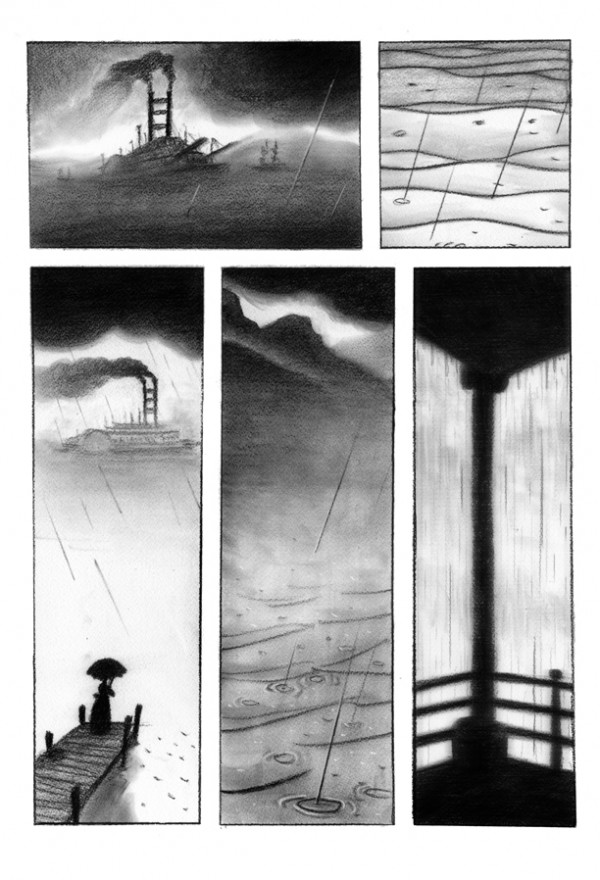 SPURGEON: The other formal thing that jumped out at me is that the structure of your pages is all over the place. There's no set grid, no set of standard solutions, except maybe that you tend to do big story moments as full pages. I think that's a consistent structural element. But your page design is very... all over the place.
SPURGEON: The other formal thing that jumped out at me is that the structure of your pages is all over the place. There's no set grid, no set of standard solutions, except maybe that you tend to do big story moments as full pages. I think that's a consistent structural element. But your page design is very... all over the place.
SIEGEL: I knew where I didn't want it to go. I didn't want it to break... it's still a very conventional window. I tried not to bring the reader out of the story and into the formal design of the page. Exploded shards of panels... I tried to keep it pretty simple. The main thing I kept checking it for was the clarity. I didn't want to have any doubt as to how to follow the story.
SPURGEON: The clarity isn't in question, but the wide variation in terms of page structure does seem to lend a nervous energy to it, in that you're never able to settle into a specific pattern. It's jumpy in a way that I'm not sure a lot of books are. Even pages that face each other than look the same, perhaps the same number of tiers, you end up varying the size of the tiers, so the reading experience shifts again.
SIEGEL: That's definitely stuff I was playing with. There's a bit of the euro influence in that. Each story beat has its own treatment.
SPURGEON: You had a very high profile, very elaborate publicity tour -- we mentioned this up top. You went out and did a lot of events related to the book's launch. That's not
typical to someone in your position. You have some things to do. You said it did disrupt some of what you had going on. I wondered about your decision to be fully present for the book in that way.
SIEGEL: The book itself, I feel like it was born from a personal journey. In some way, putting this stuff out there in a project and then fashioning a story to its ripeness, in a sense, it felt like I was shedding something. It's a little bit like letting it go -- giving it that push and getting it out in the world is a way to shed it and be free of it and move on. There's another side of me that's been treating all of this as an experiment and taking a lot of notes along the way. The webcomic and the serializing, some of that we're applying to other serial projects at First Second. Getting a taste of being out there and flogging your book, that's something we've asked our authors to do. I got a taste of that, to see what is that really like and how does that work and where does it work and where does it need improvement. I felt it was part of an experiment.
SPURGEON: I've been dying to ask you this, Mark. How sensitive were you to the fact that you're the boss, the editorial director, and you're getting author time? You're getting a certain kind of tour and certain press opportunities -- considering the fact that you have these other authors, was that a concern at all?
SIEGEL: It's definitely a delicate balance. Definitely. A lot of thought, a lot of conversation went into that here. [Spurgeon laughs] I did do my best to make sure I wasn't giving myself any special deals. Like there was a lot of stuff -- the webcomic was all on my own dime. I was basically doing my best to be as impeccable as possible with it. There was also that I did need to fulfill my duties as a First Second author with a book out. If it holds its own, if it doesn't lose money, it's part of the viability of the whole thing. And to be fair, there's always been some incestuousness to our relationships.
Colleen [AF Venable] is our designer but she's also an incredible author. She's doing a new project for us. There's a part of it where I feel that's clear. There was no secret for all of the authors. I was always doing my picturebook projects and things. In this case, doing it in house, it has problems. It's not the easiest thing to do at times.
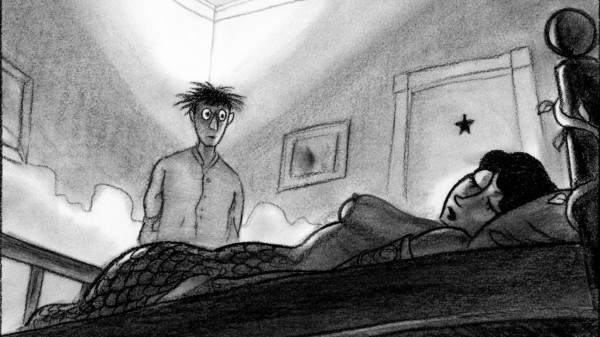 SPURGEON: You're kind of in a unique position, then. Having just said goodbye to this project, saying goodbye to this part of the journey and now looking at it with a cold eye as a publishing project, something this big -- I'm always curious when an author makes something this big and personal if the work itself has revealed anything to you for your getting a chance to look at it in this different way? Do you look at the book differently now?
SPURGEON: You're kind of in a unique position, then. Having just said goodbye to this project, saying goodbye to this part of the journey and now looking at it with a cold eye as a publishing project, something this big -- I'm always curious when an author makes something this big and personal if the work itself has revealed anything to you for your getting a chance to look at it in this different way? Do you look at the book differently now?
SIEGEL: Yeah, I do. When you put something out, you get to discover it through other eyes. There are certain things that people resonate with. Some people mention mid-life crisis, they're reading it through the eyes of a mid-life crisis. Or looking at mermaids in terms of their lives. For some people, mermaids resonate with addictions or with obsessions -- it's in there, but people have fresh insight about that. I do love books where there are mysteries. I like most things to be wrapped up pretty tidy, but I like a few things that are open-ended that might send you back into the work again. I've heard some interesting takes that people have on some things that are not my own take. There are messages in bottles that Lafayette is throwing overboard, I've heard some interesting theories about that. I'm keeping my mouth shut, I don't want to give anything away.
SPURGEON: Those are some pretty potent, broad metaphors you're tossing around there. Mermaids may be somewhat neglected, but people have been foisting significance onto them since olden times. There's a river, just the fact of the river. River travel. Your characters mirror one another, those life and love issues that are explore that way. I have to think that was on purpose -- that you wanted to use these metaphors to specific ends, but you also wanted them to keep their mystery.
SIEGEL: Yeah. Yeah, yeah. That was definitely the meditation running through it. What I tried to do with all of that -- the metaphors, but also the characters, their psychologies, and some of the historical issues -- there are currents about feminism, and black history in the 19th Century. I pushed them down a little bit -- in earlier drafts they're more prominent but now they're mostly undercurrents. I always tried to bring them back to what's real to me today. I didn't want to do an abstract thing. It's more about you govern your characters at first and later they govern you. It was a matter of spending the right amount of time with them. I wanted to play with these things, but not so much a literary conceit but because I was wrestling with stuff as we all do. We're up against ourselves and we're up against life's struggles. There are times you feel that you're really up against it and that your life is in the process of derailing or you're about to break through to a new development for yourself. So I was bringing in these big things, but out of that need as opposed to some kind of a magnum opus.
*****
*
Mark Siegel
*
First Second
*
Sailor Twain
*****
* image from opening scene of
Sailor Twain
* image from
Vera's Ghost
* cover to
Nursery Rhyme Comics
* Peggy Rathmann's picture books
* that strange Twain character design
* page design -- standard but rarely repeats
* two with Twain and the mermaid (one below)
*****
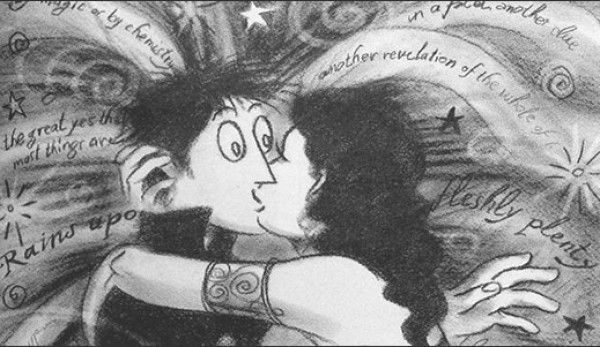
*****
*****
posted 4:00 am PST |
Permalink
Go, Look: Thirteen Going On Eighteen #10

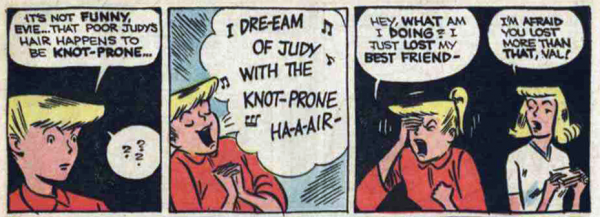 posted 3:30 am PST
posted 3:30 am PST |
Permalink
Not Comics: A Visit To Brian Chippendale’s Studio

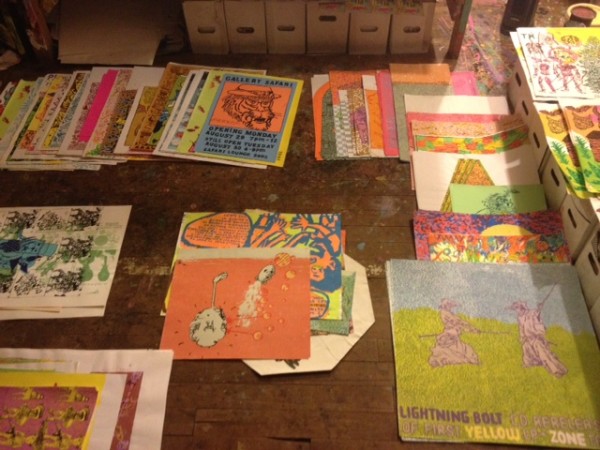 posted 2:00 am PST
posted 2:00 am PST |
Permalink
Random Comics News Story Round-Up

* the writer James Vance
has an end-of-year post up where he announces two major works for 2013: a follow-up to the now-25-year-old
Kings In Disguise and the conclusion to
Omaha The Cat Dancer.

* Eric Resetar
remembered.
*
the funny thing is, you can make compelling arguments on either side for whom this is the lousier partnership. I did enjoy the issue of the comic book they sent me, though.
* I think I've linked to this already, but what the hell:
forthcoming Victor Cayro.
* I'm coming way late to this Simon Hanselmann comic "Merry Christmas,"
but whoa.
*
Larry Reid and the Mayor of Seattle would be a pretty good buddy-cop movie team.
* did you know that Bhob Stewart
is occasionally excerpting from his forthcoming Topps book at his site?
* not comics: Michael Cho
provides illustrations for Occidental College.
* Sterg Botzakis on
Our Movie Year. Michael May on
A Christmas Carol. Sean Gaffney on
Kaoru Mori: Anything And Something. Grant Goggans on
various Legion Of Super-Heroes comics. J. Caleb Mozzocco on
DC Universe Christmas.
* finally, Simon Gane draws
Holly Golightly.
posted 1:00 am PST |
Permalink
December 27, 2012
 CR Holiday Interview #9—Carol Tyler
CR Holiday Interview #9—Carol Tyler


*****
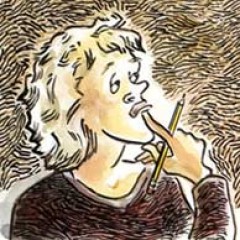 Carol Tyler
Carol Tyler is one of our great cartoonists. This year saw the publication of
the third and final book in her You'll Never Know series, about her relationship to her father and the lingering effect his time in World War 2 had on his life and that of his family. Tyler has a wonderful eye for color, a penchant for off-beat narrative structures and an underrated way with a tossed-off line. Her books would be compelling solely for the snapshot they provide into the life of a working artist, or for just getting down on paper that specific way that nature presents itself in the American midwest. I love talking to her. -- Tom Spurgeon
*****
TOM SPURGEON: You've lived with these books for a very long time. How did it feel to get some closure on this work?
CAROL TYLER: It was obviously a relief. But... during the last year of getting the book done, it was impossible circumstances. I had to finish the book by May. I wanted to get it done sooner, but the soonest I could get it done was May. I'm sure you've heard, as I was finishing up the last half of the book in the summer: it started with having to put the dog down, our 16-year-old dog. Then my mom had to go to the doctor. She ended up in a hospital, ended up in a nursing home, ended up in a coma -- this is all over a period of months -- and my sister who was helping me keep it together, we're the ones that are close to our parents physically here,
she started to feel sick in October. It turned out she had stage three and a half, four cancer, ovarian cancer. So I literally... and my dad fell, and all of this stuff.
I literally had to take the artwork -- they live four hours from me -- I had to take the artwork with me and there were days when the artwork would appear at the bedside of my Mom, at the nursing home, my sister at her hospital in recovery, the
VA where dad was and then back to staying at my parents' house. I brought pencils, ink, everything. I couldn't not work, because I had to get the book done! It was madness.
I was able to show my Mom the pages penciled. Before she passed away she saw the work. It made her cry. She said, "This is very good." And it was just so hard to do. There were times when I had to rush over there and came back, and I didn't take the work with me. It was so intense what happened, and I would come back to my drawing board here and I would sit here and feel so calm and comfortable to be at the drawing table, away from the intensity of running around. I put that intensity into the back part of the book.
SPURGEON: As I recall, you've always been one to carve out time for your work. I think "The Hannah Story" was done when you were between jobs, and had specific time to do that story then. This sounds like a completely different working experience, with the work forced upon you in a way that maybe it wasn't in the past.
TYLER: It's been like, "Gotta do the book." "Back to the book." My world was centered around sitting down, doing some more pages, "I'll be inking tonight," for so many years. I made a sign and put it above the table. You know how the dollar bill has the eyeball icon on the pyramid? I made something goofy like that with ink and it said, "I worship the God of being done." [laughter] My work style is such that I just don't write a script, and then sit down -- "Oh, I'm on page 36 now." Although I did have a system, a systematic approach. I did have a lot of order in doing the book. But yes, it was different than how I had had to do it in the past, with raising a child and kind of doing the household thing.
I set out to do this task. I jumped in. I had to find the story. I knew intuitively what it was I wanted to do. As it became... at first I just threw a bunch of stuff out there to help me find, then it became clear how the story needed to be shaped. I knew what the ending was going to be. Pretty close to the ending, although not exactly. I knew the feeling of the climax, the ending. For example, I knew I wanted to talk about Dad's fortitude in having cancer and how that was something I've admired about him. Even though he was impossible. I did write that story a couple of years ago, but it didn't fit into the took until later. There were little pieces and parts like that. I didn't do it in sequence, but I did it thematically. Then I had to, you know, sit there and try to... before book one came out, I knew the general overview. But from 2004 to 2009, when the first book was published, I did do chunks and bits, chapters -- almost like back in the day, with
Weirdo, when I would do like one-pagers, three-pagers, five-pagers, ten-pagers. It was a matter of organizing the clusters, because I had an intuitive sense of the basic theme.
The storyline hit me real strong in 2007. Then I built the pieces and parts and chunks along that. That was surprising because book three... I started book two immediately, I didn't even stop. I went from one on the drawing table to two. I flowed right through. I had difficulty in the illness in my family between books two and three, so I had... a not-complete devotion of attention to three immediately. It was still there. The drawing table was always waiting and I knew the story. I had some devices. I had part of the wall that I gridded out; I used post-it notes to help me manage the pages. Even though in book one I forgot to number the pages. [laughter] But I knew what every page that I scanned was called -- page 36 or something like that. I had a way of organizing all of the pages. I did do them according to, "Okay, I have to work on 37. What does 37 need?" And I kept on the grid a sickbay list -- page 36 needs corrections! Page 53 is awkward; there's no flow to page 54.
It was a lot to juggle.
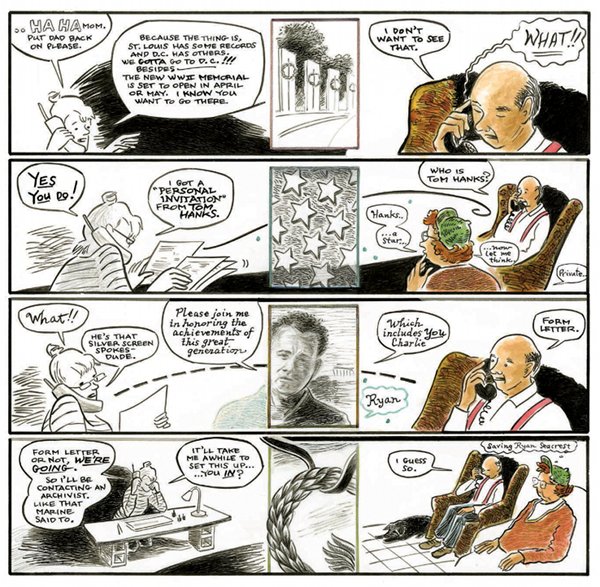 SPURGEON: Were you getting feedback from people as you were doing it?
SPURGEON: Were you getting feedback from people as you were doing it?
TYLER: No. And it's funny, because everyone knows I'm married to Justin. We do not have a buddy system for feedback for the work. So I would have to mull it over. I would go out and do some yard work, come in and just live with it. Crazily walking around the house, talking out dialogue to myself. "'That son of a bitch!' Well, no, he wouldn't say that. He would say, 'That cocksucker!' Yeah! That's what dad would say! [Spurgeon laughs] Not 'That son of a bitch!'"
So I was on my own in my own world, my own thoughts. I'd walk the dog and I'd be, "No, that's not how it goes; it goes like this." It was constantly here, constantly in my consciousness, feeling around for it, feeling around for that right vibe. Towards the end, with my parents and the illness and stuff. In the Olympics, I love this thought, Oksana Baiul was down, didn't know she was going to win the gold, so at the end of her program she throws in a quadruple toe lutz and another triple toe loop! [laughs] There were a couple of pages I did throw in off of my grid, off of the narrative. Things that had to be in there. I needed them because of what happened with my parents. I added about 20 pages to book three.
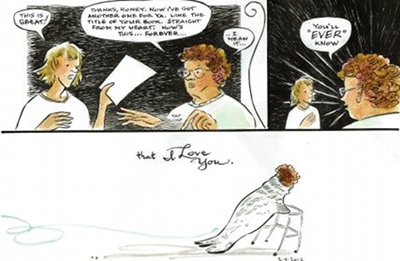 SPURGEON: Are you willing to identify some of the pages?
SPURGEON: Are you willing to identify some of the pages?
TYLER: Yeah. My mom at the beginning. I'm looking for her in the landscape. I'm reintroducing the characters. I had her years ago draw that drawing -- I said, "Mom, make a picture for the book." She kept saying, "I don't know why you have to reveal about us in public." She had the drawing, and I knew I wanted her to say that. I had to draw her leaving the panel, but she had passed away already. So where I have the lady manatee, the metaphor that came up for her, originally I was just going to talk about mothers and daughters, but I have her exit that scene on her wheelie cart. She says, "You should ever know that I love you." That's one of the things she told me before she died. "Ever know." She was riffing off of the book title. I had her in her little scooter leaving that sequence. That's not what I had planned originally.
There's another part where... my dad was not a good guy. I don't want to say that. [pause] He took her illness very hard and awkwardly. He got crankier and more off-putting. I put in that section where we go to the motel because the asbestos is all over the house. That's all true. [laughs] We go to the motel. I added the part where I had to go back and get her meds because she couldn't breathe. He's asking for his pipe. That was the way he was. She was over there in her hospice bed just wheezing away and he was trying to light up his pipe. I said, "Dad, you can't do that in here." "Hell, a man should be able..." I said, "Mom is struggling; can't you see?" So I give a touché on that.
I think the crabbiness at the end... I had him crabby, but I really pointed with those sawblades, I went to the level of his crankiness. I was so upset with his behavior. I kind of turned the dial on that one.
SPURGEON: One of the distinguishing characteristics of this work overall is the sheer number of unique narrative solutions. In this volume alone you have a text-heavy section, and these panoramic scenes, and you have the grid as well and you have these pages with a lot of white space where you drop details. It's an almost dizzying array of choices.
TYLER: Did it feel like too much to you?
SPURGEON: No. No, no. I thought that element was wonderful. There's no criticism implied in my pointing this out. My question, though, is at what point while structuring a work like this one do you land on the way you're going to approach it on the page? The fact that you're doing chunks here and chunks there suggests that maybe you're finding your way through how you're going to tell it. Maybe that's why there are so many different approaches?
TYLER: I did know that it could be jumbled, very jumbled, if I didn't have some order. Order in the court. That's why I do have the grid structure. Six panels on a page. I tried to keep some saneness that reappears except for these episodes. When we go to St. Louis, it's pages from the journal over, basically, strips of paper that I'd taken white paint to to make them try and look like roads. Paper that I tore, and like a collage, stuck it on there. I feel like... that saying in architecture? form follows function? -- there were times that I felt like I had to get the mood. There's conveying the content, the information -- communicating that. And then there's the artistic part of communication. There were times when I just had to get it across in a better way.
My mom used to say in an argument, "I'm not going to draw you a picture!" or something like that. Well, I do. That's my business. I have to convey a mood as well give you some information. So there are the words, there's the pictures, and there's the intangible element within that. That's the play part. That's what I like.
Fantagraphics gives me full range to do whatever I want. They may say, "There needs to be a hyphen or a comma" or something like that. Or this word is spelled wrong. Although very little. I pride myself on my great spelling. I don't get called out on that too much. I try to improve my word skills, try to write better because I feel like writing is my weak point. But then I'm so afraid to draw. I'm really not much of a cartoonist, I guess. [laughs] There are people that can just have at it, but it's very hard for me to draw. And writing, I was a troubled reader growing up. So I work on these things, try to improve constantly. I forgot the question! Where was I going with this?
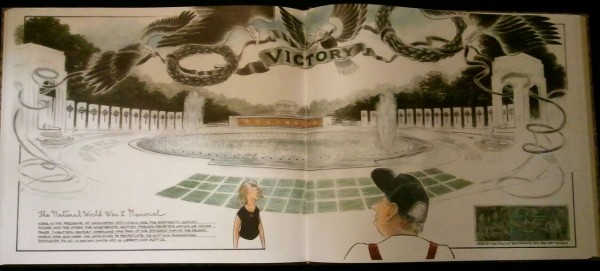 SPURGEON: Let me make it more specific. There's this climactic section where you and your father visit the National World War II Memorial.
SPURGEON: Let me make it more specific. There's this climactic section where you and your father visit the National World War II Memorial.
TYLER: Yes.
SPURGEON: The work opens up there, and you tell that part of your story in spreads. You get a sense of the scope of the place. You also use a muted color scheme, less lively than some of the earlier scenes. I was wondering how you made those choices. Maybe that will help focus my impossibly broad question! Why did you go with these vistas? I think that's really effective.
TYLER: When we went there, oh my God, it was so grand and spectacular, the space itself. When you walk into the memorial, you literally kind of walk down into it, and it opens up in its grandeur. It's wide. There's the Atlantic side over here, the Pacific side over there. It has this wide-open feeling.
I kept... here comes "intuitive" again. As I was drawing, I kept having this feeling of a circular motion, swirling air and big sky. It was all there. When I started to draw those pages, I was literally drawing gigantic ovals on the paper. I was looking for it, because I don't trace. I do reference a photo, but at some point I let it go and try to get the feel, get the vibe. I have everything up to it in the world of the comic panel -- panel to panel sequence. And then we're in the hotel room there are close-ups on my anxiety over not being able to sleep. All of that. And then, yes, as we go, get closer to it, I wanted to get the reader to the point how we fell when we were in there. Good God. It was magnificent and open and spectacular. I felt the way to do that was to open the space up. I don't know if you've ever been there, but the sky does not have birds in it with wreaths. That is confined to the towers that say Atlantic and Pacific. In order to reinforce that feeling, I didn't want to show that and then walk over there and look up and show that, I kind of combined sensations of being there and walking around that.

If you turn the page it had the columns. He wanted a picture with every state he lived in over the years. I had to make the columns as a separate thing. I wanted the gravelly effect. It's a technical thing. I made this big circular thing. I needed to have the reader look at the thing and then almost like a spiral come out, look at the four things, and then spin over to dad walking over to his side, the Atlantic. It's another circular motif. Then you turn the page again. It was, again, inspired by the space itself being near the water. They have these water features there.
He literally did have a meltdown. He's a little, bitty guy. He's shrunk with age, and he's frail. Within this gigantic space I needed to show him coming apart. What tipped him off was the sound of the water, and the names they have carved in stone of the places. His story was that he didn't know where he was, and all this kind of stuff. There would be "
Ardennes" and all of these names, and he didn't know. It made him feel that confusion again. And that water, and the bigness of it. He got lost in that moment. He fell apart.
I knew that the minute I started the comic. "Comic." [laughs] I doesn't seem like the right word. I knew the minute I started the work, I knew I had to bring the reader to the moment when we were at the memorial and he fell apart. When I first started the work --
Kim [Thompson]'s going to hate me for this -- but I did show it to some people at bigger, New York publisher companies. They said, "We don't think your dad is very interesting." One place said that. I didn't have it in the shape I have it now, I just said, "I want to tell a story about my dad. He was brave and he had cancer and he was in the war." "We don't think your dad is very interesting," was one of the answers. I remember thinking, "They don't know him." Then I thought that's my job as a cartoonist: I need to get people with me in that moment. I need to bring people there. I have to describe and define him. That set up the book.
I took it to another place a couple of years later and they said it was great, but it was too random. I didn't have my real story. They were the ones that said, "We can't work with people who are intuitive. You have to have your script written out." And I said, "I don't work like that! Sorry!" And I thought, "The hell with it. Who do I think I am? I am a weirdo artist from
Weirdo magazine. I need to approach it like that, the way that I know best. That's what works." I said, "Goodbye, New York." I can't work with an editor on this big thing. Leave me alone. That was 2007.
I had high hopes. I think it was because of... [sigh] the money, the time, the commitment! I did this on a shoestring. I did this along with... I'm going to say it. Food stamps. I did it with practically no resources. I work as an adjunct. I teach a class. That's what keeps me together. I'm poor folks, baby.
SPURGEON: I wanted to ask about another page, a little bit later than that, the conversation with you and your father in the truck after the memorial. It's almost very plain in a way. I liked the cats and dogs and the buckets, the cartoon jokes, but it's a very unadorned page. If you were flipping through the book, you would not think that this is an important scene. I wanted to know why you did this one in such a straight-forward way. Because the content... I actually gasped, took in air at one moment reading it. It was affecting. But the presentation is... was that on purpose?
TYLER: Oh, yeah. We had gone through the moments of his remembering picking up the dead and being called out as a wuss, which is why he volunteered for that job. And not remembering... the whole confusion element, his being so alone with all of that. There was this grandeur and spectacular element to the memorial, but for the most part, what we know for sure is that soldiers pretty much don't have that experience. It's little things that tip them over. Stuff they can't forget. The accumulation. What
Ernie Pyle described as layer upon layer of awfulness encountered. War isn't about
Audie Murphys. It's about regular guys like my dad, and the damage. We got to the truck, and this is the truth. It was pouring when we left the thing. Epic rainstorm. It was true, I said these are soldier's tears, stories never told. How many... I just felt how many people carried around stories. I get in the truck and I'm with one of those guys. Whose story I know. It was a flash flood; it was awful. He didn't drive because his truck wasn't available.
We pulled over. He said, "They say love is the answer." He started talking about Anne, my sister. It was shocking, because I thought we had had our moment. It was really sweet... in the little cab of the truck there, it was private and personal, like a whisper. Real plain. That's why I did that. I just wanted that to feel that way. This little... private reveal of that, how war sent him to the gates of hell but Anne pushed him in. I wanted to have that be the focus, not any of the environment. The environment is that we were in the truck, the outside world, everything had pushed us into this little spot. It was not like... it wasn't like, "I was happy and he was happy because we resolved something." It was a very quiet realization. That's what I had. I had to get the reader to that place at the memorial, and I also knew that there was something about our time in the truck -- I couldn't have them compete, but it had to be a great other side of that moment. I just kept us in the cab of the truck. Eventually we got home.
SPURGEON: You disparaged your skill as a writer, earlier, and it made me think of a panel -- not a dramatic one, almost a throwaway one -- from the wedding sequence. Right near the end. That whole scene is snappily presented and the writing seems to me to the point, and would seem to speak against your self-portrayal of a quarter-hour ago. At one point you write, "A wedding is a mash-up between loved ones and strangers who politely spend the hours attempting to sort out complex, familial alignments while slowly getting plastered." [Tyler laughs] That's a great line. How much do you worry over your writing. Do you go after every word, do you pick apart the text when you're creating your comics?
TYLER: I do write over and over trying to find the right... "mash-up." [laughs]
I've always been self-conscious about writing because I was in the bluebirds reading group. You know what that means. Sister put me in with the slow readers, the bad readers. Something like that. I was four years old when I started school, because my birthday was in November. Nowadays they would have kept me until the next year. What I learned from teaching first grade and second grade is the child's brain is ready for language, there's a window that opens up at a certain point, and you're ready to read. I was a working class girl, my mom did not read books to us at night. We had to get to bed, so that we could get up in the morning. So pleasure reading was not something that was around. I did not have any prep.
Then when I was in kindergarten I was too short, too small, and the kids would laugh at me because I would stumble on my words. I didn't know what this stuff was. I got put in the challenged group for reading. I had to play catch up throughout school. I think that's why I developed this kind of thing. I had to read the world based on visual clues and sound.
I did learn one thing about myself throughout this book: sound is everything to me. When I hear somebody say something to me, I remember how it sounds as much as what they said. More. It's the sound that becomes the shaper of the form. I know with the wedding I have to go [Tyler sings a series of musical "doots"]. You know? [Spurgeon laughs] Then I figure out the words on that. I walk and talk around the house. I'll go for a walk. I'll get in the shower. I'll order and frame up the words, in the shower, talking through the words. It's something I need to nail down. You gotta have in comics, I feel, you have to build a great house. That's the architecture. That's the panels and the order of the writing, all that stuff. Then the plumbing, that's the words and the composition of the art. I said it was troublesome to draw. I get the panels drawn, the words written. I often have to go back and re-do it because it has to ring true. Then I start to work on the drawing. That's when I get to nail-biting. I have no confidence in my ability to draw. Every panel I draw I have to struggle with, "Can I do this? Uh-oh. I don't know if I can draw. I don't know if I can do that." Then when it's done it's like, "Oh my God." So I try another one. Every single panel I have to get all my confidence together and move forward. It's not easy. When you go to book signings and people pull out their sketchbooks and say, "Can you draw me a picture?" I can't! I have pencil it and work it over a couple of times... I have no confidence. It's a struggle for me.
I'm glad you brought that up about the words. I'm very concerned with the writing and the language and how it reads. I do obsess more over that. I'm equally obsessed about how the picture looks within the panel and how the panel works within the page, so that the whole thing has a sense of being something that works, that leads to the next page and come from the page before.
 SPURGEON: You mentioned in an interview once that you would talk to people to get dialogue closer to what they might actually say. Do you do that with the visuals, too? Do you tweak, or check with people, about the visual aspects of your comics?
SPURGEON: You mentioned in an interview once that you would talk to people to get dialogue closer to what they might actually say. Do you do that with the visuals, too? Do you tweak, or check with people, about the visual aspects of your comics?
TYLER: You have to make sure you got the right lamp in the room. Otherwise it's somewhere else. What somebody is wearing. Mom's wardrobe, her
JCPenney's wardrobe is throughout the book. Dad, he was pretty simple because he always wear the same clothes: the blotchy, stained pants. The suspenders.
Through the book I wanted to make sure I captured my own transformation. When Justin leaves at the beginning I'm wearing a
49ers jersey. Could you get any more unsexy or girly attractive than that? Right? At the time, when he left, the 49ers were the team in northern California. I didn't have a jersey but I had... Julie had one or something. That was the mode o' day. I was right in the middle of the raising the kid thing. Women do not feel sexy and all that stuff... you just can't. You have the kid, you have the homework packet. So many things. Another thing: I have to look like a sex object all the time! That takes a low priority. You want to look nice. And aging is starting a hit. So in that panel, I wanted to draw a 49ers jersey because that was as far away from romantic awesomeness as I could get. As I transform through the book, I transform my look. I get back into my being. Everything from my hair to the way I travel around in the panels. It's clothing. It's telephones! At first I'm on a land line. At the end I've got a cordless. There's a cell phone. Cars. Everything. All of these details. I knew I had to show across the time... a phone can really anchor an ear. A well-placed black telephone. We still have a black telephone with a coil. We still use it.
SPURGEON: We talked in 2009 when the first book came out. You expressed some anticipation that the book might garner reactions from other children of veterans. Your generation, and feeling the burnt of this undiagnosed trauma they went through. I wonder how that developed. Did you hear from other people? Do you think your work has been reflected in work that others are doing? Or has that not developed the way you wanted it to?
TYLER: I'm kind of disappointed that it hasn't had that audience. I know that is a great audience. I'll tell you why. This last Fall I was at
the Military Writers Society Of America -- there's actually a group like that. I was asked to do a presentation. Twenty very devoted people came. They were blown away by my presentation. Not only because these are people that write, and I showed them: "And now you gotta draw it." I have a powerpoint about what the studio looks like, and the effort. They were amazed by that. There were also people there who had written on the topic. There's a woman,
Leila Levinson, she had written about the very same topic. We didn't meet until that conference. We became fast friends. She believes the same thing, that this is the big shaper of our generation. And we have it in our minds to put together a conference. We wish we could roll it back 20 years because the baby boomers are retiring and moving to Costa Rica. What do they care about issues? When people of my generation, and they find it and they read it, it really resonates with them.
I'm sorry about the way the bookstores... you go to the graphic novel sections and there's
Hellboy! [Spurgeon laughs] There's Chris Ware's
beautiful, giant thing. There are all these other great titles. But someone that is interested in history or World War 2, or the things that this would strike with them, they're not going to go to that section. I've said that before at the library. I've asked, "Why you can't put it with the military writers?" Put it next to Leila's book,
Gated Grief -- it's about post-traumatic stress. Put it out there for the veterans to find. Amazon, come on! Categorize it. It's under graphic novels, and then women's graphic novels. Those are the categories. If you like Fantagraphics and you want women cartoonists, you're going to find my book. But if you're a military person, you're not going to get to the book. Why are there these screwed-up categories?
SPURGEON: I think that's coming. Slowly.
TYLER: We were saying that 20 years ago.
 SPURGEON: When I told a bunch of people I was going to interview you, announced it on Facebook or via Twitter or something, I heard back from about a half-dozen folks -- about par for the course -- but this time they were all fellow women cartoonists. I remember when you went to San Diego a couple of years ago a lot of the female cartoonists I knew there attended your panel. Do you feel a connection to the younger women cartoonists working right now?
SPURGEON: When I told a bunch of people I was going to interview you, announced it on Facebook or via Twitter or something, I heard back from about a half-dozen folks -- about par for the course -- but this time they were all fellow women cartoonists. I remember when you went to San Diego a couple of years ago a lot of the female cartoonists I knew there attended your panel. Do you feel a connection to the younger women cartoonists working right now?
TYLER: Wait a minute. Did you say you heard back from younger women cartoonists about my work?
SPURGEON: It was actually all women cartoonists. That's what I'm saying. Usually I hear back from a range of people. This time it was only women cartoonists that wrote me. I wondered if you felt a connection, because it seems like they may feel a connection to you. I think your work is admired, generally.
TYLER: I find that funny. Not funny ha-ha. I find that interesting because as a cartoonist -- and you know this is true -- you work in your bubble, your isolation unit, and I don't get to go to these conferences. I went to San Diego by the grace of being asked to come. I don't have the resources to travel around and promote my book. I'd love to do that. I haven't had time, and then last year with my family in such a difficult state I didn't have time to go to any of these things. I probably should go and meet people. Get out more. I've got a lot of
Facebook friends and I know people through Facebook and maybe having met them at a couple of conferences. I feel so inadequate because I can't meet the need. If someone comes out with a great book and I see it and I love it, I don't know what to do about that other than say, "Oh, your work is great. I really like it." It sounds so fake.
I try to be supportive. I try to
like. I hit the "like" button on as many people as possible. But I don't have fast friendships with the women that are working, probably just because of the physical... I remember hanging out with
Aline [Crumb], for example. And
Diane [Noomin].
Phoebe [Gloeckner]. We physically hung out together. We'd go to
Ron Turner's burrito party. There'd be some function at Aline and
Robert's. I don't know how close you can be as a friend just by hitting a like button. I'm kind of embarrassed and sad about that. We don't get to show up physically for each other. I can't show up physically. I'm honored and pleased to know that women showed up in terms of this interview. I feel honored.
SPURGEON: You're always honest about the costs of being a cartoonist. Do you worry after younger people that want to make comics or that wanted to try something like you just completed? Is the cost of doing this kind of work something you worry about for others?
TYLER: Do you think people would be surprised to know that I did food stamps to get the book done?
SPURGEON: I don't think surprised as maybe gratified that you would talk about it so openly.
TYLER: About poverty?
SPURGEON: About how tough it can be to make art, or orient yourself towards making art, unless you're very lucky. A lot of the very youngest artists have come up in this age where there really were some book contracts out there at one point [Tyler laughs], and it seemed like that was a thing that might continue. Some of the cartoonists I've talked to this year, those under 35, a lot of them are readjusting their expectations.
TYLER: Because of the economy.
SPURGEON: That, and because suddenly fewer people want a book from them -- maybe not a second book, maybe not a first.
TYLER: How do you get one of those? That would be fun. [laughter]
Fantagraphics and I have a hippie handshake deal. Which is fine because we're from a different generation. I trust Kim and
Eric [Reynolds] and
Gary [Groth]. They've done okay by me. It's not been New York prices, but it's been what they can do. I'm okay. I'm not in foreclosure.
All right... here's the deal. I'm an art nun. [laughter] You take a vow of poverty when you enter this business. It's not about the lifestyle, it's about how can I get this work done. So the first thing I learned as an artist when I went off to art school back in the '70s was you get a job that won't drain you emotionally and will allow you to have the time to do your work. I've been working under that same paradigm. And if you work hard, you'll get a bigger gig. You have to stay the course. I have had times in my life where I've taken -- this is the absolute, god-awful truth -- go through the pantry, take a couple of cans and return them so I can buy a tube of red, a tube of yellow and a tube of blue. Maybe a tube of white. Get some cardboard, and do a little bit of art. I still have returns I do because I need a bottle of yellow ink. At the same time, I can't put forward poverty as my opening shot. People can't see my hobbling reality. They need to see the triumphant result. My art will outlive me. Not my poverty. That's not going to matter. What matters is on the page.
I gave up a long time ago on a fancy wardrobe. I'm a thrift store girl. I gave up a long time ago on vacations. When I'm asked to come to San Diego, I make sure I do a little sight-seeing and have a little fun when I'm there because that's my vacation. I can't afford to go the Cayman Islands. I just came back from Europe. Someone graciously, the
Amadora Festival... Portugal... that was wonderful. Otherwise I would not have been able to go to Europe.
I could not have done this book as a young person. Not just because of the obvious chronology, but because I wasn't ready. I didn't have the emotional connection with some of these broader themes. When you're young you want to draw about young people things: the rent, the landlord, the boyfriend. Which is what I did when I first started out. Cursing them out in print.
I don't know if it's right to air my reality here. "Whoo! This girl's poor!" [laughter] For the younger people, if they're going into it thinking they're going to have contracts, or a certain lifestyle? No, no, no, no, no. You go into this to say something. To communicate.
*****
*
Carol Tyler
*
Carol Tyler at Fantagraphics
*
You'll Never Know Book One: A Good And Decent Man
*
You'll Never Know Book Two: Collateral Damage
*
You'll Never Know Book Three: Soldier's Heart
*****
* cover to the latest book
* self-portrait by the cartoonist, the one used for the Chicago conference earlier this year
* one of the dizzying variety of narrative solutions employed in the book
* an added scene
* the big memorial spread, photographed because I couldn't manage to scan it even though I thought I could
* Carol's dad getting his picture taken in front of those various state columns
* one of the lovely dropped-border panels that Tyler occasionally uses
* the sturdy grid
* compelling, dream-like image from early in the third volume (below)
*****

*****
*****
posted 4:00 am PST |
Permalink
Go, Look: A Bunch Of Ed Wheelan Comics

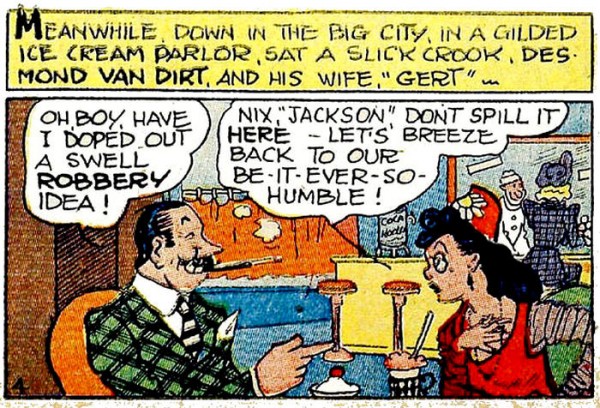 posted 3:30 am PST
posted 3:30 am PST |
Permalink
Go, Look: DC Comics December 1972 Covers

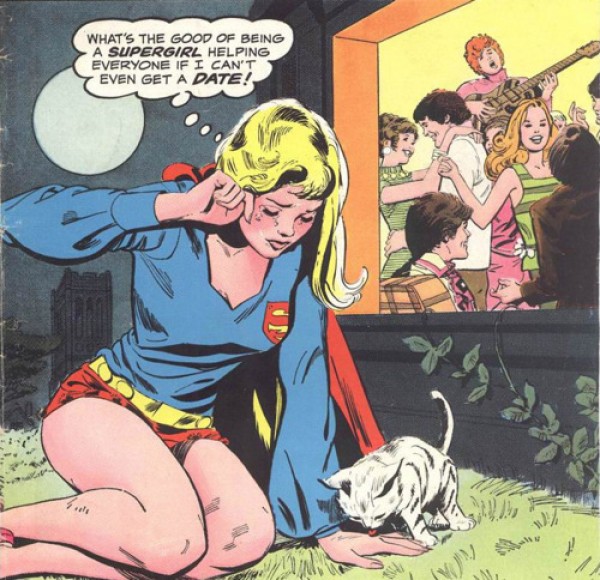 posted 2:00 am PST
posted 2:00 am PST |
Permalink
Random Comics News Story Round-Up

*
USA Today comics point man Brian Truitt
adds his voice to those putting together best-of-year lists.
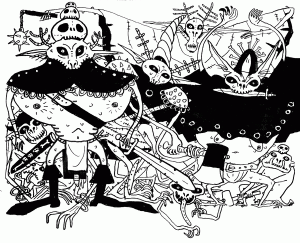
*
DnD night with Eleanor Davis. It was
fruitful.
*
Leah Rule, RIP.
* so I guess the writer Matt Fraction
is putting on-line post-issue footnotes and production commentary for his
Fantastic Four-related gigs.
* Alex Dueben talks to
James Romberger. Steve Morris talks to
Allison Baker. Casey Gilly talks to
Thien Pham.
* not comics: hey, remember that little bookstore with the chairs and the fireplaces and the copies of
A Wrinkle In Time out on a little wooden table and your parents let you run around and you stared at the Edward Gorey books?
Here's the opposite of that.
* Chris Mautner on
Spacehawk. Chris Ware on
the books of Laura Ingalls Wilder.
* here's a rare treat:
Paul Karasik blogging, this time on inked flesh and baked goods featuring Fletcher Hanks art.
* finally,
forthcoming Victor Cayro.
posted 1:00 am PST |
Permalink
December 26, 2012
 I Love Going To The Comic Book Shop
I Love Going To The Comic Book Shop

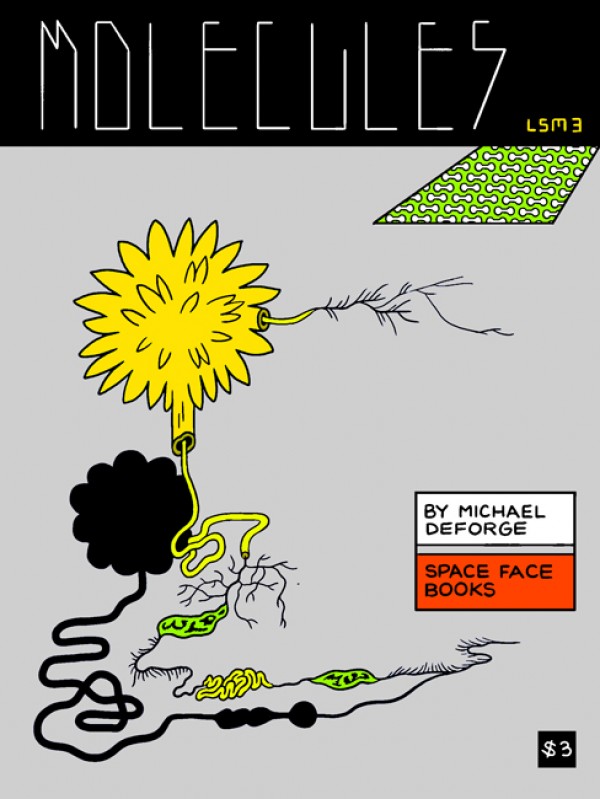
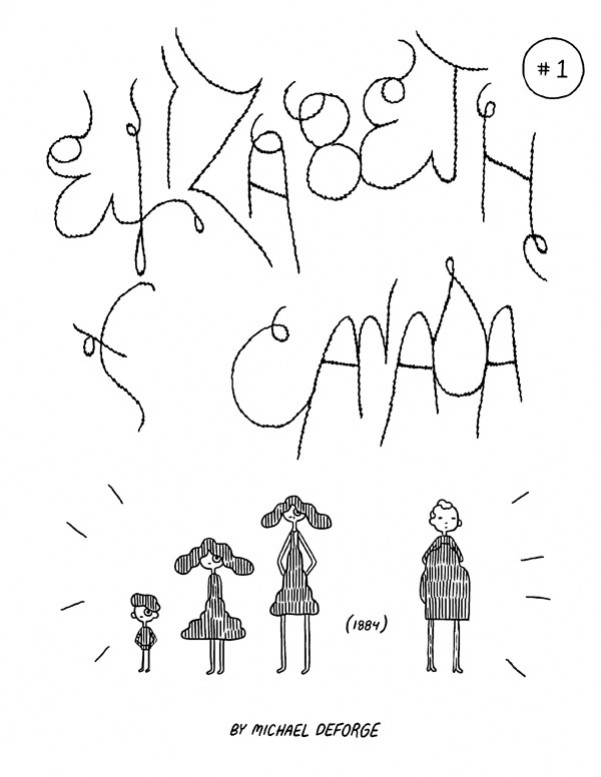
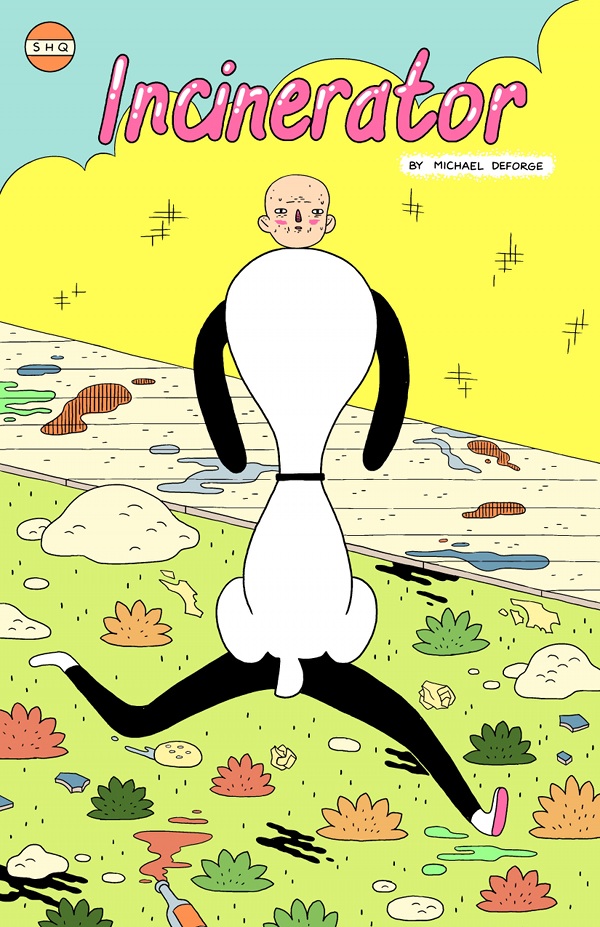
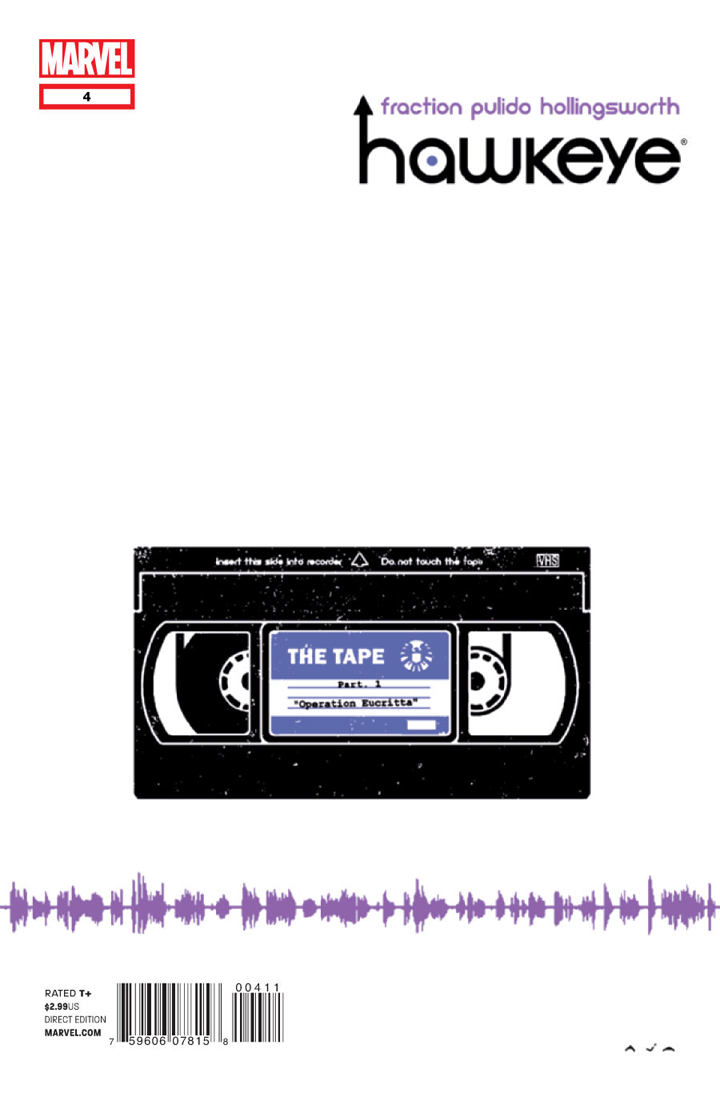
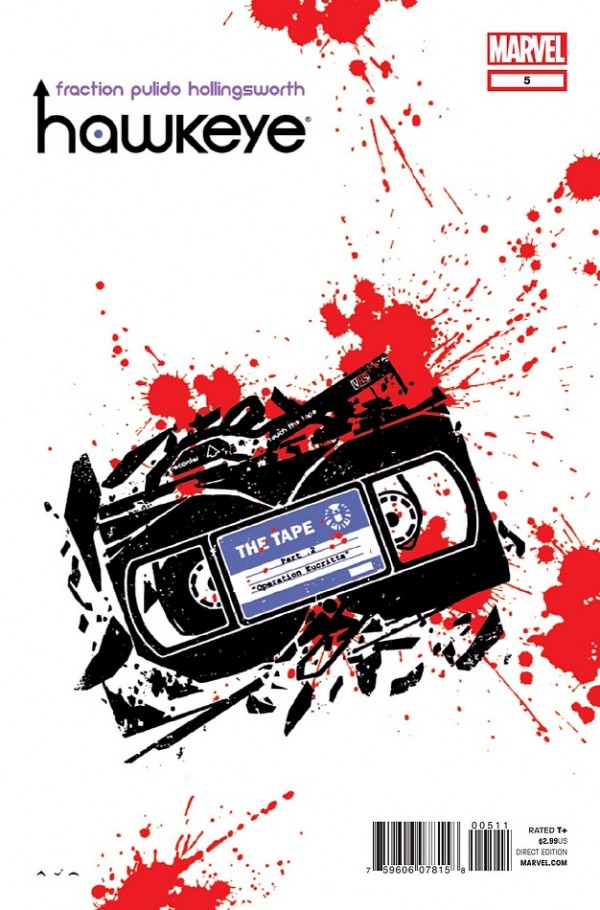

This was at
Secret Headquarters on December 19. I don't remember the cost, but I paid with a $20 bill and received change. Despite the combination of mini-comics and superhero books, it didn't feel like I overpaid based on that old standard of perceived time invested in the reading, for whatever that's worth. I think there may have been one more comic, too.
posted 11:00 pm PST |
Permalink
CR Holiday Interview #8—Marc Sobel

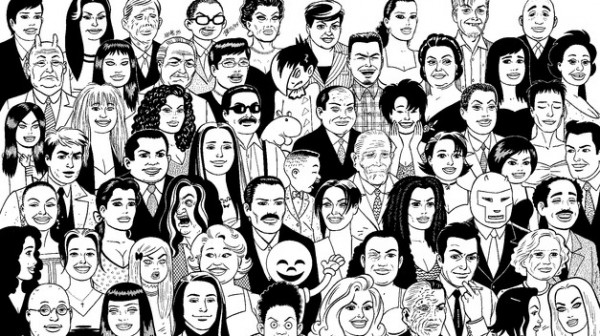
*****

I know just about one thing concerning
Marc Sobel, but it's an important thing for 2012. He's written about
the Hernandez Brothers extensively on-line, work that's now been shaped and fashioned into two forthcoming books from
Fantagraphics:
The Love And Rockets Companion and
The Love And Rockets Reader. That's an interesting story in and of itself, how a writer in today's industry landscape can start by engaging material that interests them on some level on their own and end up with a formal publishing arrangement. So I'm happy to hear Marc talk about that a bit, in the hopes that we'll all benefit from people similarly following their passions in some way. Mostly, though, I thought it would be a fun way to engage the massive achievement of Los Bros Hernandez during the year we celebrated their 30 astonishing years in comics. Thirty years of making work considered near the top of the art form is a rare, remarkable accomplishment for any artist in any medium. That we're talking two men that happen to be brothers and that this has taken place in the ruthless, fickle arena of North American comic books makes what they've done even more special. I was thrilled to get to talk to Sobel about this. Los Bros Forever. -- Tom Spurgeon
*****
TOM SPURGEON: Marc, I'm familiar with your work after years of reading it but I have to admit that I don't have a strong sense of exactly where you publish and what and for how long. Can you walk me through your professional affiliations in terms of your comics writing, where you do it and how long you've been working for your various outlets?
MARC SOBEL: I've published stuff all over the place. When I first started writing about comics, back in 2000, I wrote reviews for a now defunct British pop culture web site called
Insomniazine. It was pretty amateurish stuff and thankfully all those reviews are long gone.
Around 2003 or so, I started writing for
Comic Book Galaxy after
Alan David Doane posted an open call for writers. I've always admired and appreciated Alan's honesty and candor about comics, so I was excited to be a part of that site. For about three years, I was really prolific, writing multiple reviews per week. While I was cranking those columns out, I was also teaching myself the craft of writing reviews by reading a ton of other, better critics.
In 2006, I got involved with
Sequart Research & Literacy Organization after meeting the site's founders at the
New York Comic Con. They were just starting out and were actively recruiting new writers. I pitched them my idea of doing a column focused on
Love & Rockets and they were all for it. About a year or two after that, I started writing semi-regularly for
The Comics Journal, mostly long-form reviews, but I also did a few interviews. I had an article printed in
TCJ #300 and I recently did
an in-depth interview with Theo Ellsworth for the web site -- I also have another interview forthcoming.
Over the years I have also posted pieces at
The Hooded Utilitarian,
The Great Curve,
The Graphic Eye,
Comics Forum and occasionally on my own blog,
Unattended Baggage. These days I mostly post my work at
The Comics Journal, although my online presence has been minimal since I am still finalizing the
Love & Rockets books and am also busy working and raising two young boys.
SPURGEON: Can you place your comics work in the context of any and all other work that you do -- particularly writing, but not solely -- and in terms of how you've interacted with comics in other ways? I mean, I assume with most writers about comics that you were a reader first, and a very devoted one, but that's not always the case anymore for me to make that leap without asking. But are there comics that were important to you as you developed as a writer, or that were important to you generally?
SOBEL: Comics have been a part of my life since before I was old enough to read. My dad used to own a pharmacy in St. Louis when I was really little and they had a spinner rack there with comics on it, mostly
Marvel and
DC stuff. Every once in a while, I would go to the store with him on a weekend and if I cleaned off and dusted all the shelves, he would let me take a couple comic books and a candy bar. This was how I first discovered superheroes and
Star Wars, and I was instantly hooked. I've been an obsessive collector ever since.
In terms of my career as a writer, I see the work I do as a way to share my love for the medium with others who feel the same way. It's also a way to justify the huge amount of time and money I spend on collecting and reading comics. If I could work as a writer or scholar or editor full-time, I'd be thrilled, but it would be hard to support my family doing that. So I basically do this because it's fun, but at the same time, I also take it very seriously and hold myself to a very high standard.
 SPURGEON: Am I also right in that you have some ambition to make comics of your own? Or that maybe you even have? I'm thinking that you took a trip to Sri Lanka and wanted to make a comic from that, but didn't.
SPURGEON: Am I also right in that you have some ambition to make comics of your own? Or that maybe you even have? I'm thinking that you took a trip to Sri Lanka and wanted to make a comic from that, but didn't.
SOBEL: Yeah, I self-published a photo-memoir called
14 Days in Sri Lanka about my wife's family. My mother-in-law is from Sri Lanka and her family's story is fascinating. My wife and I travelled there in 2005 and I basically made a travelogue using photos and journals from our trip. At one time I had considered trying to draw it and pitch it as a graphic novel, like
Guy Delisle's books, but I realized I didn't have anywhere near the skill to pull that off. So I just assembled it in Photoshop and posted it online. I don't think very many people read it, but it was a great gift for my wife and her family.
I've always wanted to write comics and I still expect that someday that will happen, though I haven't done anything to actively pursue that end in years. But right now, all my energy and enthusiasm for comics is channeled into my critical writing. I do have a half dozen or so graphic novel scripts that are completed and ready to go. They're just in need of a good, reliable artist which has always been the trouble for me. I've worked with a lot of talented artists over the years, but none have ever stuck around long enough to finish a story.
I've also self-published a few mini-comics over the years. Back in 2004, I printed 500 copies of a mini called
Starfish which was a 12-page sci-fi story penciled by
Leigh Gallagher, who has done some work for
DC Vertigo --
The Witching -- and is now doing some amazing work for
2000AD. I actually inked that book myself with a mouse, if you can believe it. A couple years later, in 2006, I also self-published a book of poems and a short story with illustrations by my friend
Leontine Greenberg, another amazingly talented artist.
In 2009, I wrote and drew a 32 page mini-comic called
The Red Stiletto. Partly, I was inspired by the Hernandez brothers do-it-yourself attitude, but I also just wanted to experience what it was like to create an entire comic by myself. I have no art training and very little natural skill, but I did manage to finish it. It was an adaptation of an old poem I wrote years ago. If nothing else, it was a good learning process and I blogged about the lessons I learned from that whole experience.
SPURGEON: How did you start the writing that's led you to write so very much about the Hernandez Brothers? Where did that idea come from, and what kept you writing along those lines? You mentioned the pitch to Sequart
, but I imagine there's a bigger story there.
SOBEL: In 2006, I contributed my first piece to
The Comics Journal, which was an interview with
Dan Nadel about his new book, Art Out of Time.
Dirk Deppey posted it on a very early iteration of the site. I don't think it's even online anymore. Around that same time, I decided that if I was going to write for the
Journal, and follow in the tradition of guys I admired like
Gary Groth,
Kim Thompson,
Bob Fiore,
Bob Levin, and so many other great writers over the years, I needed to educate myself in the classics of the medium. That's what led me to start reading
Love & Rockets. I thought, "If I'm going to express an opinion about other people's works publicly, especially for the
Journal, I want to be informed about the medium's history." I'm still working on that, and probably always will be, but I've learned a ton about comics history since then.
So I decided to read
Love & Rockets in its original format and blog about each issue as a way to teach myself about one of the medium's classics while still keeping active as a writer. I really had no idea what I was committing to, and I'm sure a lot of people thought I was crazy, but I had no clue. I just wanted to have fun with it.
I decided to publish those early columns on
Sequart rather than
Comic Book Galaxy because they were offering the opportunity to collect all my columns into a book once I finished. At that time, they were just getting started with their publishing arm and the two main editors -- Mike Phillips and Julian Darius -- were really excited about my little project. In fact, I owe a lot to them for being so encouraging in the early days. I'm not sure I would have gotten out of the starting gate without their support.
About a year later,
Sequart crashed and was offline for a long time. Thankfully I had a backup of all the work I'd done; I think I was around halfway through the series at that point. I thought about trying to move it all to another site, but with so many images and columns, it seemed like a lot of work. So instead, I decided to just put the whole project on hold. My wife and I were expecting our first child around then -- in 2007 -- and I was feeling overwhelmed by it at that point anyway because I wasn't sure how to continue working issue by issue as I got deeper into the series.
So, for about a year, I didn't look at
Love & Rockets at all, but then in early 2009, I decided to resurrect and finish the book, mostly because I just wanted to keep reading the series, but also because I had put so much work into it. Since I wasn't sure if I would actually finish it or not, I decided not to post any more online and I just began working on it privately. I figured if I did manage to finish it, I could always find a home for it, though I never imagined it would be with Fantagraphics.
 SPURGEON: The natural follow-up, then, is how this developed into a book. How different is what's to be published from your original writing?
SPURGEON: The natural follow-up, then, is how this developed into a book. How different is what's to be published from your original writing?
SOBEL: The Fantagraphics books are very different, and much better, than my old Shelf Life columns.
What happened was at
the MoCCA Festival in 2010, Jaime was in town promoting
the new Ti-Girls collection from Love & Rockets New Stories #1-2. I had never met him, so I was excited to go and introduce myself. I had just finished a very rough draft of all 50 columns at that point and so I put together these little one-page fold-over brochures describing what
Shelf Life was and including some of the nice quotes I had gotten -- including one of yours actually, Tom -- and printed up a few copies. I gave one to Jaime, who I was surprised to learn had read some of my columns when I was posting them on
Sequart.
I also gave a copy of that flyer to
Eric Reynolds and he asked me if I had finished. I told him I had, and he said to call him when he got back to Seattle and that Fantagraphics might be interested. That was pretty exciting, as you can imagine. It actually took several months before we connected, but when we finally did speak, we discussed the possibility of publishing my work as part of the 30th anniversary of the series.
Once it sank in that Fantagraphics really was interested, I realized I had to completely edit and improve the book, especially the early columns, which had been written without any sense of perspective on the series as a whole or the Hernandez brothers' place in comics' history. As a result, I undertook a massive research effort where I was reading every piece of scholarly writing and hunting down every interview I could possibly find related to
Love & Rockets and the Hernandez brothers. In the process, I rewrote almost the entire first half of the book.
I also recognized that I had to restructure the book since it doesn't really make sense to write about
Poison River or
Wig Wam Bam in an issue-by-issue format. So I reworked all of the sections on the longer stories as well. I also added chapters on
Mister X,
Brain Capers and
Birdland, as well as a "
Love & Rockets Pre-History" chapter. 2010 and 2011 were very intensive and that's why I stopped blogging and went completely offline to focus.
In October 2011, my wife and I had our second son. Leading up to that was the most insane period of writing I've ever experienced; I was working on the book every spare minute and even took a bunch of vacation days from my job to work on it because I knew I had to get a complete draft to Fantagraphics before the due date. I think I sent the manuscript off to Eric sometime in early August, and after that, I spent a couple months madly preparing to interview all three brothers, which I did just a few weeks before my son was born.
 SPURGEON: Talk to me about the 30th Anniversary. Do you think that went well, that they received at least some of the credit they were due? I mean, I know that's impossible, but it seemed to me there was some genuine goodwill for them at San Diego and at SPX, and comics isn't exactly a place that recognizes people in that way.
SPURGEON: Talk to me about the 30th Anniversary. Do you think that went well, that they received at least some of the credit they were due? I mean, I know that's impossible, but it seemed to me there was some genuine goodwill for them at San Diego and at SPX, and comics isn't exactly a place that recognizes people in that way.
SOBEL: I think so. I didn't make it to San Diego, but I was at SPX and I definitely felt like there was a lot of goodwill. It was great to see that the fans and pros there voted the Brothers for three
Ignatz Awards: Outstanding Artist to Jaime, Outstanding Story to "Return To Me" and Outstanding Series. I also thought both Jaime's and Gilbert's panels were very well attended.
I also know that the Brothers did
a tour of the East Coast and also had
a party at the Fantagraphics store in Seattle. There were some neat things on the web as well. I thought
Sean Collins' tribute was really nice. I think these are good signs and show the respect people still have for the Bros. How many other cartoonists can you think of that are celebrated like this in the middle of their careers? Though there are many who probably should be.
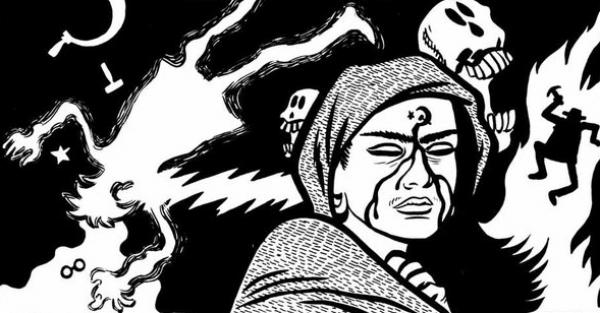 SPURGEON: Now, were there stories or issues of
SPURGEON: Now, were there stories or issues of Love & Rockets
that really hit you in a certain way. I know for me that Death of Speedy
, "Bullnecks and Bracelets," "For The Love Of Carmen" and the Frida Kahlo story were all comics that hit me like a ton of bricks. Can you talk a bit about the key stories in your own estimation of their accomplishment, what stories might have stuck with you more than others?
SOBEL: That's a tough question. I've read the series so many times, all of the stories are memorable to a degree. Even individual panels or sequences stand out sometimes.
Looking at Jaime's work, I definitely agree with a lot of fans that
Flies on the Ceiling is a masterpiece. The way Jaime was able to nail Izzy's back story after so many years of not knowing exactly who the character was, even though she was there from the very first issue, is just amazing. It's such an incredibly satisfying payoff. Even the way he explained the symbolism of the flies was perfect. And there's so much natural beauty in those 12 pages, it's a pleasure to read over and over.
 The Death of Speedy
The Death of Speedy is another one that's unforgettable. The ending, despite knowing its coming, was still surprising, beautiful and heartbreaking all at once. Plus, that's the story where Ray really first comes to life, and it was clear immediately that Jaime had a great grasp on his character.
And of course, like everyone, I really loved
New Stories #3-4. Having spent so much time studying these characters, those stories really hit me hard. Especially when Ray got attacked. I agree with a lot of people that those new stories may be Jaime's greatest work to date, not because they're necessarily better objectively, but because they bring so much of the past into clearer and deeper perspective, while still remaining perfectly true to the characters. I sometimes think people take for granted how incredibly difficult it must be to write the same characters over and over for 30 years. There aren't very many artists who've even attempted it, at least not in such a realistic human way.
But then, of course, Jaime also has some stories that I think are kind of underrated. "Camp Vicki," for example, is just awesome. The structure of that story, the way it swings from past to present and fleshes out Vicki's background, which informs her long-running feud with Rena is so impressive, and it's also one of the best examples of Jaime's ability to draw characters at different ages.
"Tear It Up, Terry Downe" is an impressive short story for its economy and symmetry. That kind of formalism is pretty rare in Jaime's work.
With Gilbert, I really love his Palomar short stories from the teen issues, just before
Human Diastrophism, especially "Holidays in the Sun," the story about Jesus Angel on the prison island. That was such an astounding psychological journey that he put Jesus through in just 12 pages, and yet it worked. I also think Gilbert's compositions in that story are some of his best from the early part of his career; you could really see him developing in the way he staged his scenes. There's one panel in particular where Jesus discovers that his friend Obregon has killed himself that blows me away every time I look at it.

I also love the cinematic narrative style of "Ecce Homo," the way the camera keeps wandering through this crowded party like an anonymous guest, picking up little bits of personality and revealing background about the characters. "The Way Things're Going," that four-page story about Vicente and his friend searching for work, was the first time I really felt like Gilbert blew me away with his prose.
There are also certain character moments from larger stories that really affected me. For example, the rape of Ofelia in
Poison River is one of the most moving and unforgettable scenes in the entire medium. The courage and strength she showed by warning off baby Luba while being physically brutalized, it's just so powerful. And all that emotion was conveyed silently; it's such a masterpiece.
Gilbert also has some stories I think are kind of underrated. For example, "Mouth Trap," where we first start to see a human side to Fritz and Petra, after their insane escapades in
Birdland. That is such a heartbreaking yet beautiful story and Gilbert is such a master at doing children characters.
Gilbert also produced some real gems in the period following
Poison River. "Hernandez Satyricon" in particular is one of his most underrated stories. The mayhem and the mad, crazy energy of that story, all targeted at the ancient history of the series and filtered through a
Fellini lens still blows me away.
I could go on and on.
SPURGEON: Do you think there's something about reading those comics as a comic book series that might be lost to readers that get at the stories in a collection? I know that there are many people that read a bit into how the stories play off of one another?
SOBEL: I think ideally the first 30 or so issues are best experienced in their original serialized format, although the material is so strong it can be read in a variety of formats. But the individual issues are how they were originally conceived, and the stories were designed specifically to be read as comic books, as opposed to the longer works which followed.
There are a lot of little things that are lost when the material is collected. For example the covers, both front and back, informed the stories inside each issue. Also, the letters columns were an essential part of the experience of reading
Love & Rockets. Those hearken back to the brothers' love of old Silver Age comics where fans could directly engage with creators. Actually, in the
Companion, I've excerpted some of the highlights from
Love & Rockets' letters columns because they really were an integral part of the journey. Also, the way the brothers played off each other, whether it was influencing each other's storytelling, especially in the early years, or the way the characters would occasionally cross over into each other's universes, were all part of the shared creative space. By pulling each brother's work out and separating it, you lose that sense of balance.
Even the graphic design of the individual issues, and the house ads for all the merchandise, or other Fantagraphics titles, were part of the beauty of the series. You had some really talented people doing in-house page layouts for the inside covers, like
Dale Yarger's movie poster-style inside cover of Maggie holding her suitcase in issue #40. All of that stuff may not be important for people to appreciate the brothers, but to me, I'm really glad I experienced the work for the first time in its original format and I'd encourage others if they really want to have the full Hernandez experience, to do the same. That being said, I of course recognize that those old issues are out of print and hard to find, and I would never want people to think that the new collections aren't worth their time. Of course they absolutely are.
The final 20 or so issues, particularly with the longer works --
Wig Wam Bam,
Love and Rockets X and
Poison River -- those I think actually are better when read in the collected format as opposed to the original issues. For one thing, the brothers, especially Gilbert, added a lot of additional pages to the collected versions which were not in the original issues and these additions really do enhance the stories. So, to me, in those cases, the collected editions represent the brothers' final visions. Also, those stories are so complex, it is better to focus on each one rather than try to follow all three at the same time like they were originally presented.
The one exception to that, I think, is
Human Diastrophism, which I still prefer in the original issues better. For one thing, the collected version, at least the latest 2007 reprint, excluded the title pages from that story which is a shame, because Gilbert designed some really wonderful opening splash pages for each chapter that break the story up and are also just beautiful in their own right.
SPURGEON: Who is the audience for your L&R
books? For that matter, what was your audience like for the original essays? You said Jaime was reading a few of them, but I assume that he's not a typical reader.
SOBEL: Well, I have no idea who was reading the original essays. I guess just fans of the series, or whoever happened to find my columns while Googling the brothers. I didn't get very much feedback, though from time to time I would get a nice supportive email from someone asking me to keep going and finish the series.
But with the Fantagraphics books, I tried to write them so that they would appeal to anyone with any interest in the series at all, including longtime fans, new readers, scholars and students. It's a fine line, but since I am not affiliated with a university, my work didn't necessarily need to include all of the theory and methodology that a lot of academic writing has which can sometimes make it dry or hard to penetrate. I tried to write very directly so that anybody, no matter what their background with the series, would be able to access it.
At the same time, I recognize that this is a series that means so much a lot to people, and I didn't want to short change anyone. That's why I did such an extensive amount of research. I really tried to give readers, especially fans who've been reading the brothers' work for 30 years, something much more worthwhile than just my impression of
Love & Rockets. My goal was, whether you're a longtime fan or new to the series, for these books to deepen your appreciation and understanding of the series. I also hope that a lot of people who maybe haven't read
Love & Rockets in years will be tempted to take a fresh look at the series.
I also recognized that some people might just want to read about their favorite stories, rather than a full study of this magnitude. That's another reason why I structured the book to mirror the latest reprints, so it would be easy for someone who just wanted to read about the origins of
Errata Stigmata, for example, to flip to that section and read my write-up.
 SPURGEON: I know that for all they have accomplished, you could look at this year as significant in light of two perceived snubs: they weren't invited to the conference in Chicago that assembled all of those great cartoonists, and Jaime didn't receive an Eisner or a Harvey nomination for work that was at the top of a lot of best-of-year lists. Do you have a guess as to why they're sometimes not perceived in the first order of cartoonists by various bodies?
SPURGEON: I know that for all they have accomplished, you could look at this year as significant in light of two perceived snubs: they weren't invited to the conference in Chicago that assembled all of those great cartoonists, and Jaime didn't receive an Eisner or a Harvey nomination for work that was at the top of a lot of best-of-year lists. Do you have a guess as to why they're sometimes not perceived in the first order of cartoonists by various bodies?
SOBEL: Well, I have no idea about the Chicago conference, but regarding the Eisners and Harveys, I just think that there is a whole new generation of comics fans now that didn't grow up with
Love & Rockets, and although they know who the Hernandez Brothers are, and have some familiarity with their work, they haven't gotten around to reading the series because there's a huge amount of material and it's kind of overwhelming. I think that's an unfortunate issue that a lot of artists face as they get older, especially when they're as prolific as the bros.
It's also about accessibility. Even though there's that "
How to Read Love & Rockets" page on Fantagraphics' website, and I know
Chris Mautner did a "
Comics College" essay on the brothers' work, a lot of people just aren't sure where to start.
I also think that we've reached a point in the comics industry where there's so much new material being generated, that it's impossible to keep up with even all the high quality stuff. So, at least from my very limited perspective, the industry awards kind of reflect that. I think of the Eisners and the Harveys as more mainstream-leaning awards, which is why you get votes for books like
Daredevil; whereas the Ignatzes are pretty much exclusively for the alternatives. Sure, there are some crossovers sometimes, and that's because super-fans like me tend to still have a foot in both camps, but on the whole, people usually gravitate to one side or the other. I could be overstating it, but I don't necessarily think that's a problem, just a reflection of the current state of things.
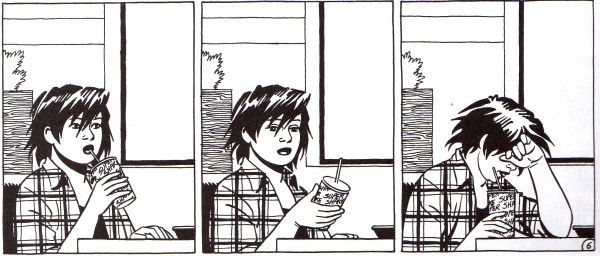 SPURGEON: Something that Gilbert has talked about a few times is that maybe he and Jaime and Mario are in an odd place vis-a-vis younger cartoonists because they deal in the practical solutions they learned from mainstream comics and are very story-oriented. At the same time, you mention that it's the Ignatzes and not the Eisners or Harveys that honored the Hernandez Brothers this year. Do you think Gilbert's point is correct? Why haven't we seen more cartoonists working that same general area that Jaime and Gilbert work?
SPURGEON: Something that Gilbert has talked about a few times is that maybe he and Jaime and Mario are in an odd place vis-a-vis younger cartoonists because they deal in the practical solutions they learned from mainstream comics and are very story-oriented. At the same time, you mention that it's the Ignatzes and not the Eisners or Harveys that honored the Hernandez Brothers this year. Do you think Gilbert's point is correct? Why haven't we seen more cartoonists working that same general area that Jaime and Gilbert work?
SOBEL: That's a tough question. First of all, I'm not sure I 100% agree that alternative cartoonists are moving away from storytelling entirely. What I do see happening, though, is a shift away from the open-ended, mainstream-inspired style of storytelling used in
Love & Rockets toward more discrete graphic novels. To me, this is mostly driven by the publishing market and fans who want complete stories in a single package. It's also probably a function of the disappearance of major-publisher-supported serialization of alternative comics. But I see lots of storytelling in the graphic novel side of the industry.
I also think you have to look at what influences cartoonists. The Hernandez brothers grew up with heavy doses of comic books and television/movies. Those influences inform their entire bodies of work. So, when you think about their stories, they obviously go to great lengths not just on the visual aspects, but also the dialogue, characterization and plot. Ultimately their main goal is to tell entertaining stories. But a lot of newer cartoonists have moved beyond that goal. The current generation of alternative cartoonists, at least in some cases, though certainly not everyone, seems to be moving closer to the fine art end of the spectrum.
So I think, in some ways, we're in the next stage in the evolution of alternative comics. When you look back at the history of modern art, you can see each generation trying to define itself in contrast to what has come before. Like with the Pop Artists, or abstract expressionism, it's an attempt to distinguish yourself from the past, so to speak. It's demonstrating that, 'hey, art can be something else than what we have always accepted it to be, and here are some examples.'
To an extent, I see this trend playing out in the current alternative comics scene. You have a movement, though it's kind of unstructured and vague, against narrative storytelling, especially the really detailed, literary kind of storytelling that the Hernandez brothers pioneered. Now you have things like abstract comics, or very surreal stories where the idea seems to be that comics are just sequential images and don't necessarily need to tell a coherent story. Just a couple of weeks ago,
Sean Collins interviewed Aidan Koch for The Comics Journal and she said that "to be honest, I don't feel like I'm really trying to tell stories. I don't care if people don't totally 'get' what's going on." In some cases, alternative comics don't even have to look professional anymore, either, because sometimes they are intentionally ugly or crude as a statement against what popular conceptions of beauty are.
I do understand why the brothers may see this move away from story as a problem, and I tend to share their tastes, but I think it's just a natural part of the evolution of the medium. It may also just be part of a larger cultural trend where comic books are taken more seriously now.
Also, it is important to recognize that many of the younger artists working in this new context have produced some truly magnificent work.
Al Columbia's Pim and Francie, to name just one example, is an absolute masterpiece, but there is very little narrative there. Same goes for
Theo Ellsworth's Capacity, which is a work of genius. And there are many others.
So, I think it's just where the creative energy of this new generation of cartoonists is focused, but to me, it's encouraging that the medium is big enough and diverse enough to accommodate these new types of work, as well as the more traditional ones.
SPURGEON: Talk to me about all of those influences for a second... is there something that you see in their work that you might have to convince me is an influence, something that you think is underplayed as an influence on either cartoonist?
SOBEL: Well, the brothers have talked at great length about their many comics influences, so I'm not sure I have any hidden ones to reveal, but I do have a long section in the Reader where I tried to pull together all of the various discussions they've had over the years regarding their diverse influences. The one area that I think is still an unknown, or lacking in sufficient details, is the extent of the influence of b-movies on their work, especially Gilbert's. I do explore this to a degree in the books, and even moreso in my interview with them, but my familiarity with these old movies is limited so it is hard for me to talk specifics.
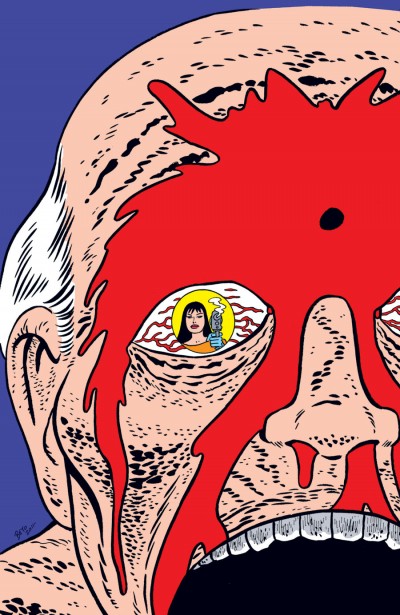 SPURGEON: What do you think in general of Gilbert's more recent work? It has its detractors and its champions.
SPURGEON: What do you think in general of Gilbert's more recent work? It has its detractors and its champions.
SOBEL: I fall firmly in the "Gilbert is one of our greatest living cartoonists" camp, although I do understand why people have a hard time with his more recent work. The stories that resonated with people back in the '80s and '90s were very focused on realistic human characters living in a world that seemed familiar, even if it wasn't. That allowed readers to relate to the characters and, like Jaime's work, built a bond that for years Gilbert mined to great effect.
Suddenly, starting in the final issues of
Love & Rockets Vol. 1 and solidifying with
New Love, that all ended. Even though Luba and her family were still featured in many cases, once they left Palomar, it was like the spell was broken. So, people who wanted more of the same were left out in the cold, and the impact of that was magnified because Jaime stayed the course.
But, if you take a step back and look at Gilbert's more recent work objectively, without constantly comparing it to the Palomar stories, there is no question he is a stunning visionary with a unique sensibility. In fact, part of what I find so fascinating about Gilbert is that he's like ten different cartoonists in one, and he can do them all so successfully. For example, a story like
Julio's Day, which is going to open a lot of eyes now that it's finally being collected, shows that he can still do the kind of sensitive, character-driven human realism that made his Palomar stories so beloved. Yet, at other times, he can do sweet, little charming children's comics, like the Venus stories in
Measles. Then there's another side of Gilbert that can channel the insanity of the old underground comix creators like
Crumb or
Wilson, with all the wild sex and over the top violence.
Girl Crazy and
Birdland, or even the new series,
Fatima, are all good examples of this. And along similar lines, sometimes he'll just go completely crazy and do these short pieces that are absolutely surreal like
Rick Griffin or
Robert Williams. Then just when you're not expecting it, he'll turn around and hit you with a fun, little
Peter Bagge/Daniel Clowes-style gag strip, like the Roy stories, which are just hilarious. And he can even pull off straight-forward, authentic autobiography,
a la Chester Brown, like in "My Love Book," his
RoadStrips piece, or the forthcoming
Marble Season. And then, of course, there are the Fritz b-movie books which, since they're the longest works he's done in recent years, garner the most attention. These allow him to explore his love of old movies and recreate the kind of obscure lost schlock cinema he's become an expert in.
I think this constantly shifting focus gives his overall body of work a manic quality than can drive people who just want more Palomar stories nuts, but to me, it's at the heart of what makes him so fascinating as an artist. I can't think of anyone in the history of the medium that is half as versatile as Gilbert. I'll admit I don't love every single thing he's done since 1996, but on the whole, I always find his new work at the very least interesting to examine and I honestly believe he's produced at least half a dozen masterpieces, all of which are sadly underappreciated, since the end of that first series of
Love & Rockets.
 SPURGEON: What do you think of Mario's comics? Is there one you'd recommend over the others? Is there a way you think his influence is felt that we might not see at first?
SPURGEON: What do you think of Mario's comics? Is there one you'd recommend over the others? Is there a way you think his influence is felt that we might not see at first?
SOBEL: Well, you have to be careful not to judge Mario based on his early "Somewhere in California" stories in
Love & Rockets. Those are pretty rough compared to his later work. I think the first thing that Mario did that really blew me away was that back cover from
Love & Rockets #9, with the airplane and the car going off the edge of a cliff. I looked at that piece and immediately thought of Jack Kirby. As I was going through the series for the first time, it got me really excited because I thought Mario was going to show up more and blow me away like his brothers, but obviously he faded into the background.
I do think that Mario is a much better writer than people give him credit for. He's definitely inspired by Gilbert more than Jaime, like in
Me for the Unknown, which dealt with a lot of the same themes that Gilbert explored in
Poison River, like America's cultural imperialism, the impact of globalization, etc. He's also got a pretty sharp sense of humor which I think really came out in
Citizen Rex.
As an artist, Mario is obviously nowhere near his brothers, which he freely admits, and yet he does have some very impressive stories. I think his best work is his children's work. Like the stuff he did in
Measles, for example, which is really fantastic. The story "The Legend of Celestra" from
Measles #2 is one of my favorites.
Also, at the end of
Brain Capers, there are two stories for children which I think are the standouts of the book. His linework in those pieces is really open and airy and it's a style that suits him well. Supposedly he's working on a couple of different graphic novels, so I'll be very eager to see what he's got planned next.
SPURGEON: This might not work with everyone's comics, but I wondered if you might talk a little bit about their characters. Is there a character or two that you find particularly affecting? For instance, I always liked Daffy Matsumoto, because I played a similar role in my group of friends: the slightly younger true believer.
SOBEL: Speedy Ortiz, without a doubt, really hits home for me. In the Fall of 2010, my brother-in-law committed suicide and it was such a long, drawn out, painful process (I blogged about it here) that it's still hard to read
The Death of Speedy without thinking of that whole painful experience. It's weird, but they even kind of look similar to each other.
As far as personally connecting to the characters, I found the punk attitude of the main characters, especially Hopey and Luba, inspiring. There were a lot of times throughout the project where I started to doubt myself and then I thought, fuck it, I'm just gonna do this and try to enjoy it and screw anyone who doesn't like it. I didn't grow up with punk at all, so that attitude really helped me to finish.
SPURGEON: You've been super-careful to mention that the Hernandez Brothers are in the middle of their career, and I agree with you that we should see years and years of work from them yet. At the same time, it's hard not to see your work as something that speaks to their more general legacy. Do you think they'll have a specific place in comics history? Is there anything about how they'll be viewed 50 years from now, say, that might surprise us?
SOBEL: Well, if the brothers stopped making comics today, I think their legacy would have several components. First, they would be celebrated -- as they already are -- for being among the first creators to have to have broken down the barrier that comics could only be about traditional genres: super-heroes, horror, fantasy, etc. They also were the first artists to seriously explore diversity and multi-cultural issues in a meaningful and intelligent way in comics. They also proved that comics are a medium with limitless potential, and they inspired a generation of creators to make comics the way they wanted to, rather than the way some corporation or audience expects. On top of all that, they created some of alternative comics' most enduring stories and characters.
But, of course, they're not close to the end of their careers and if I could try to speculate into the future another 20 years -- a very risky proposition -- I think Jaime's work will be regarded as one of the very best sustained narratives ever produced. The real-time aging of his cast of characters will be studied and enjoyed forever.
Of course, Jaime has a major challenge ahead of him as well, and that is answering the question of when and how his characters will die -- or if they will at all. I can't imagine how Jaime will address this, as I'm sure the thought of killing off Maggie or Hopey, characters he's worked on for three decades must be incredibly difficult. It will be fascinating to read.
Gilbert's future is harder to predict, partly because he is always going in so many different directions. I think the legacy of his early Palomar work is cemented, even if he goes back to tinker with it from time to time, but I hope that in the future, people will also recognize his more recent comics -- especially books like
New Love,
Julio's Day,
Chance in Hell, and
Hypnotwist, to name some of my personal favorites -- for the masterpieces that they are, and avoid comparing everything to Palomar. I also have no doubt that Gilbert will produce many more brilliant stories. So, at this point, if I had to guess, I'd say that Gilbert's legacy will be as one of the most versatile and visionary artists ever to work in the medium.
*****
*
Marc Sobel
*
The Love And Rockets Reader
*
The Love And Rockets Companion
*****
* black and white art from
Love & Rockets Vol. 1 #50
* photo of Sobel provided by Sobel
* from the Sri Lanka work mentioned
* from the Ti-Girls saga
* from the Los Bros 30 panel at Comic-Con
* from the Frida Kahlo story
* panel from
Death Of Speedy
* I believe that's from the story Sobel mentions there; only about 98 percent sure, though
* cover from early in the run of volume one
* storytelling in a traditional way
* later Gilbert work
* comics from Mario
* Gilbert and Jaime signing at SPX (below)
*****
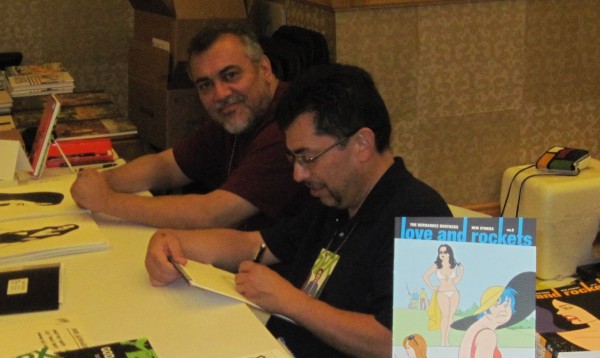
*****
*****
posted 4:00 am PST |
Permalink
Go, Look: Reed Crandall And Al Williamson Art

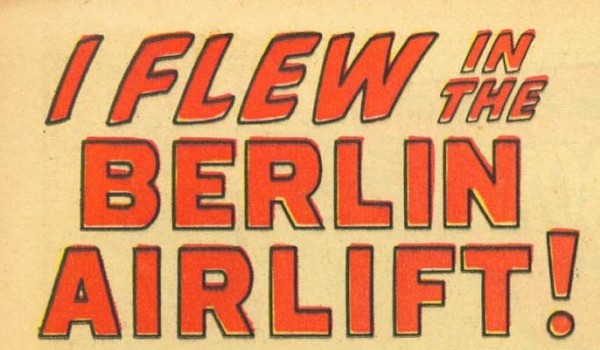 posted 3:30 am PST
posted 3:30 am PST |
Permalink
Not Comics: Guts Of Glory Bonus Cards

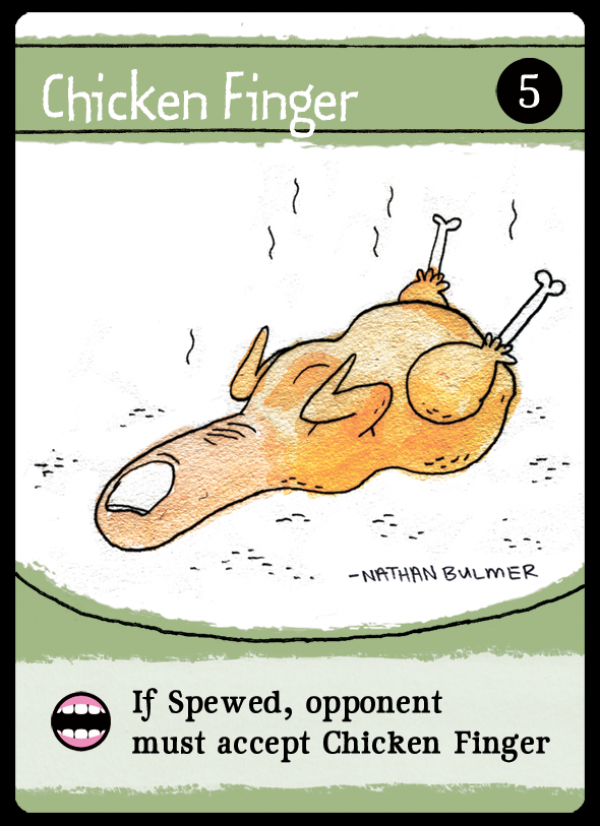 posted 2:00 am PST
posted 2:00 am PST |
Permalink
Daily Blog Archives
November 2019
October 2019
September 2019
August 2019
July 2019
Full Archives


